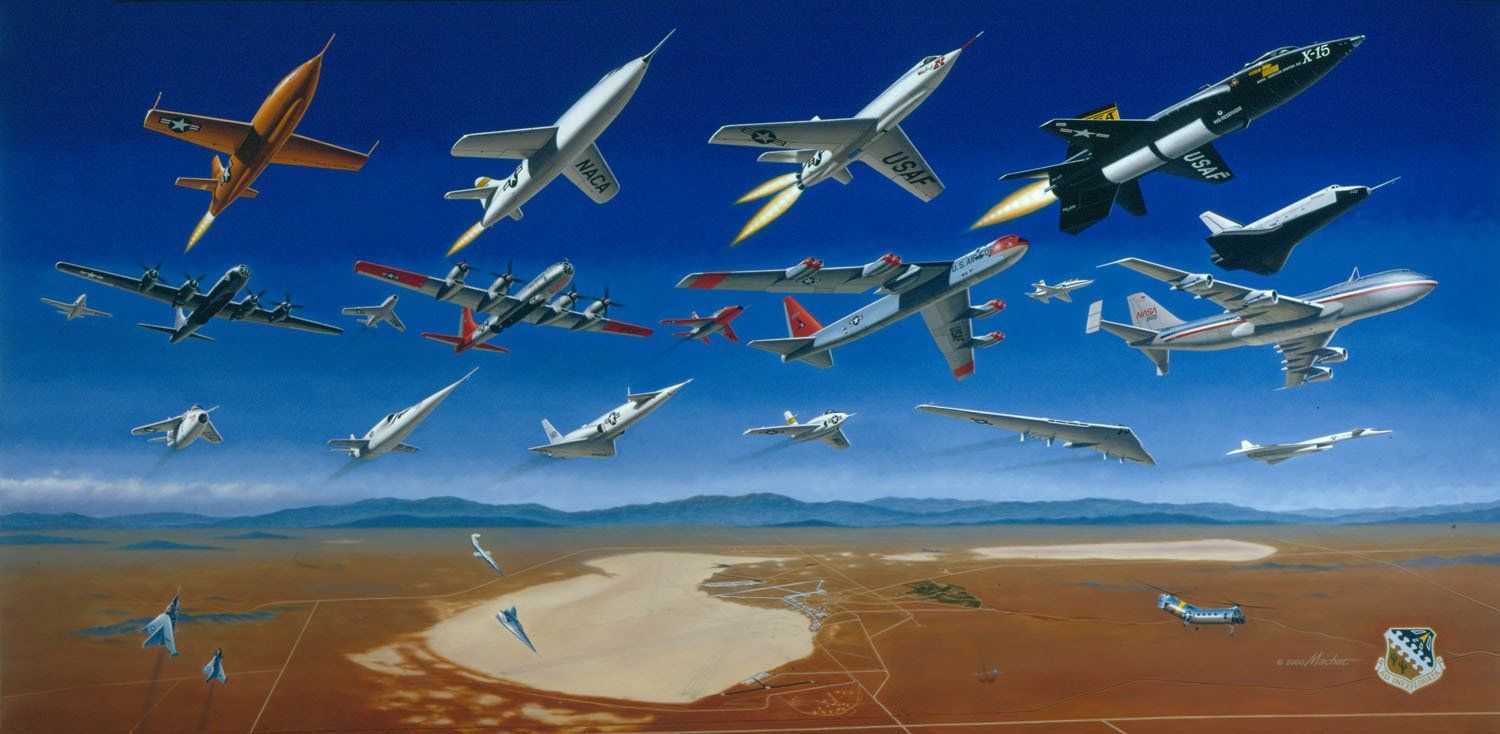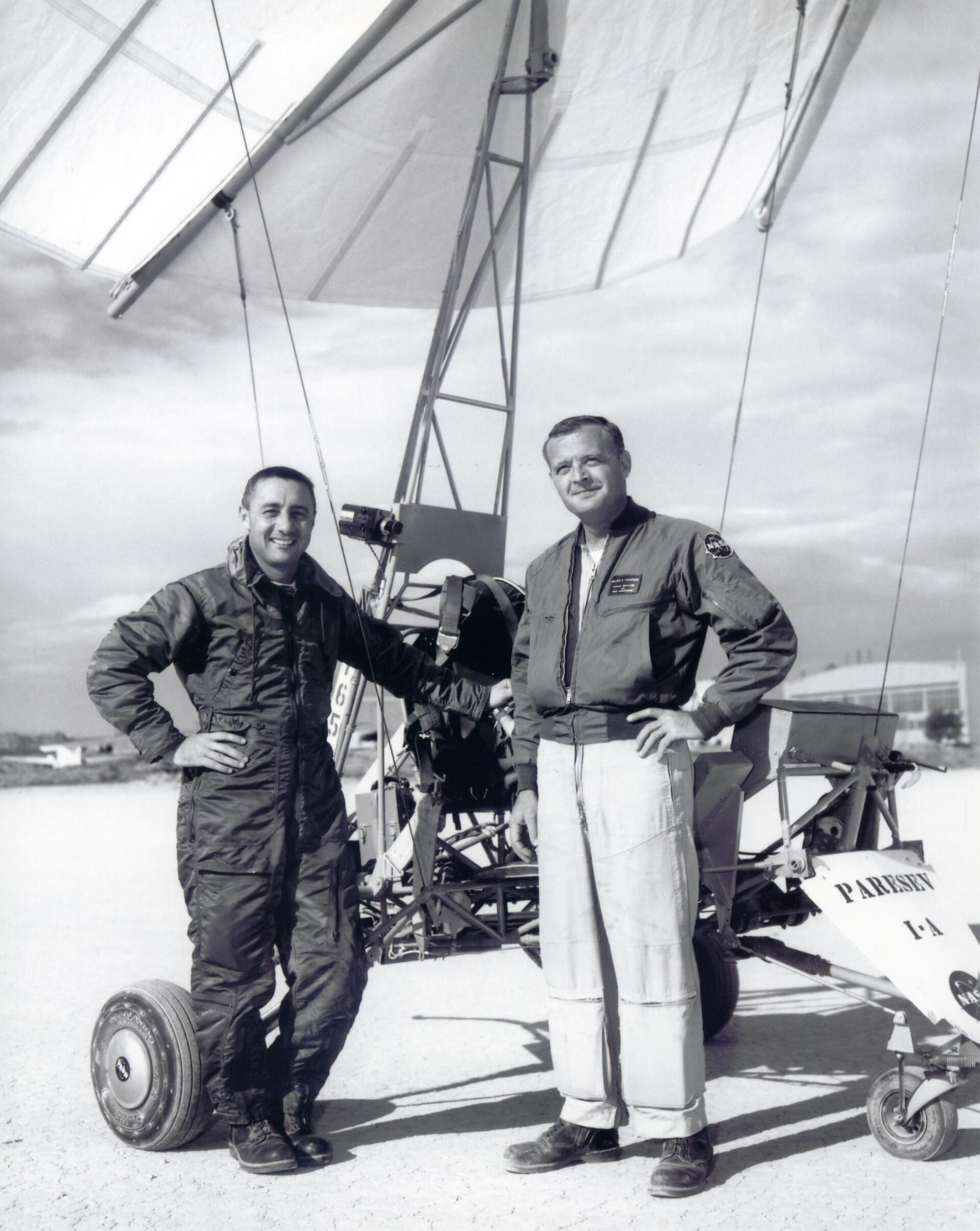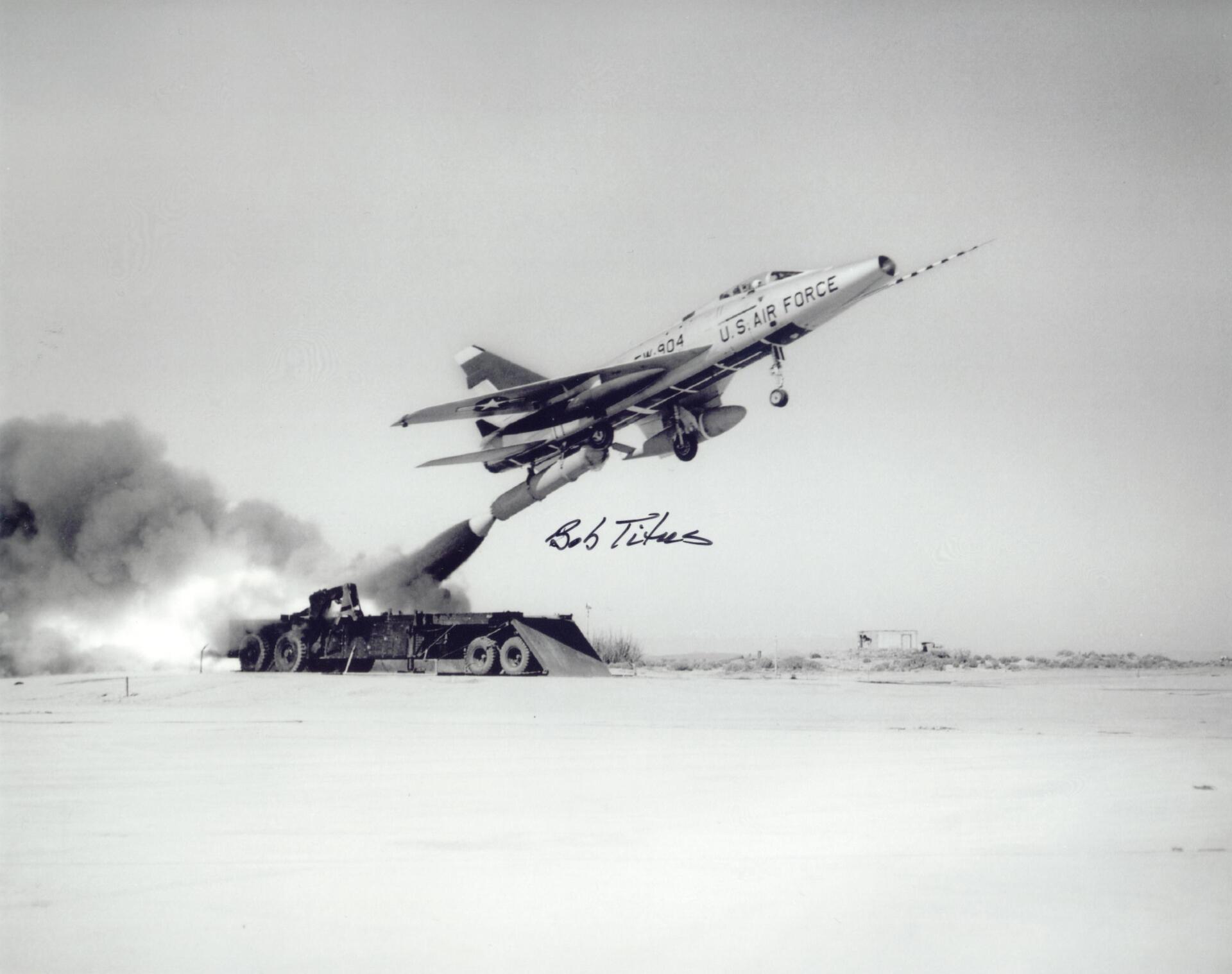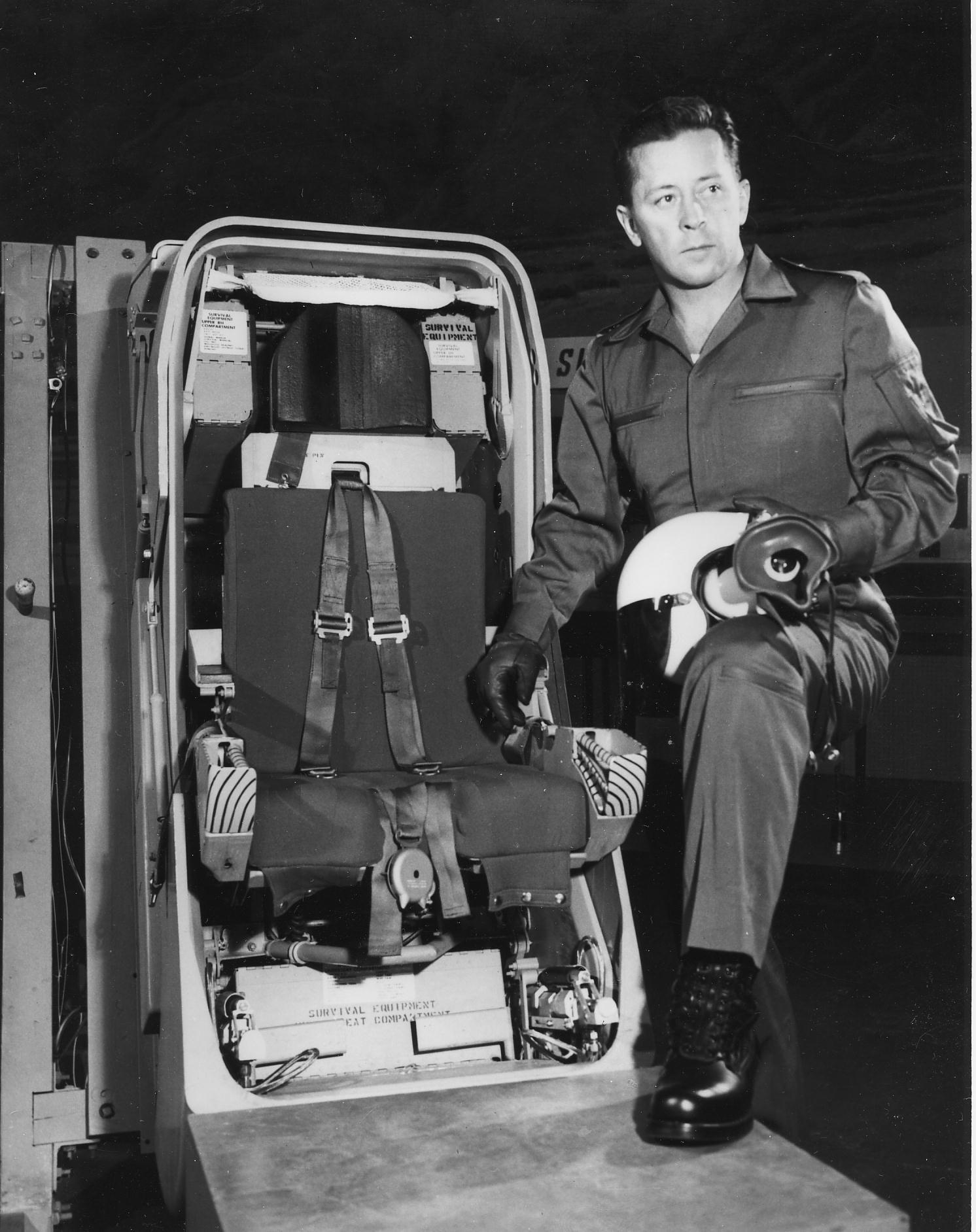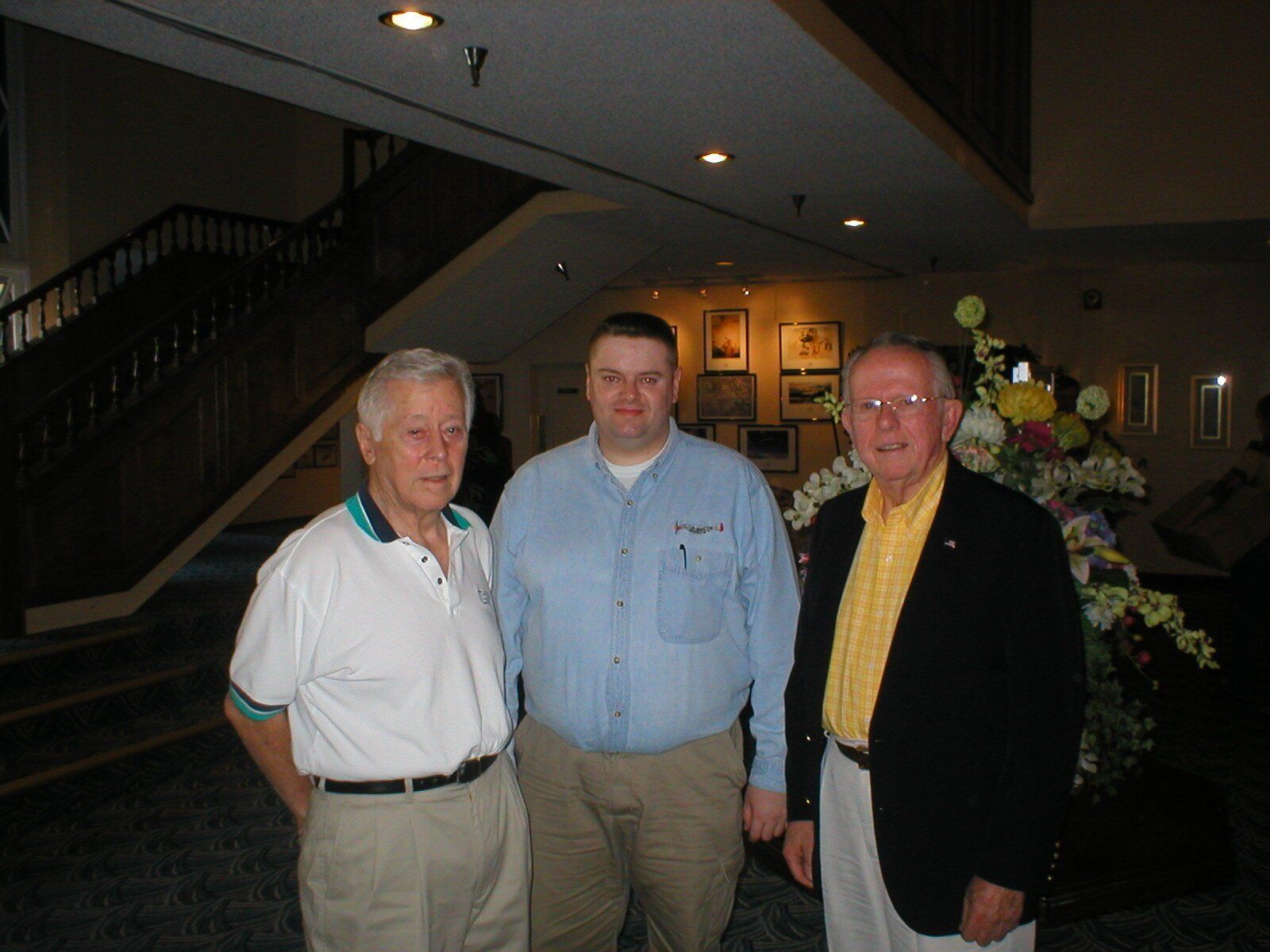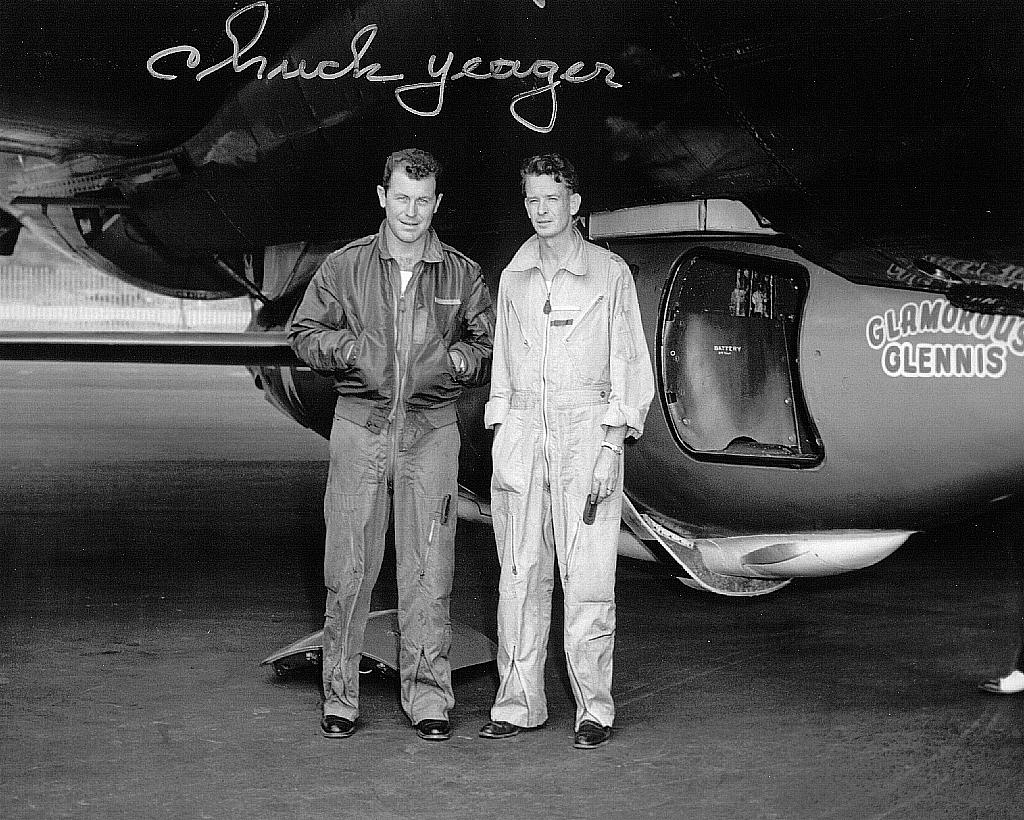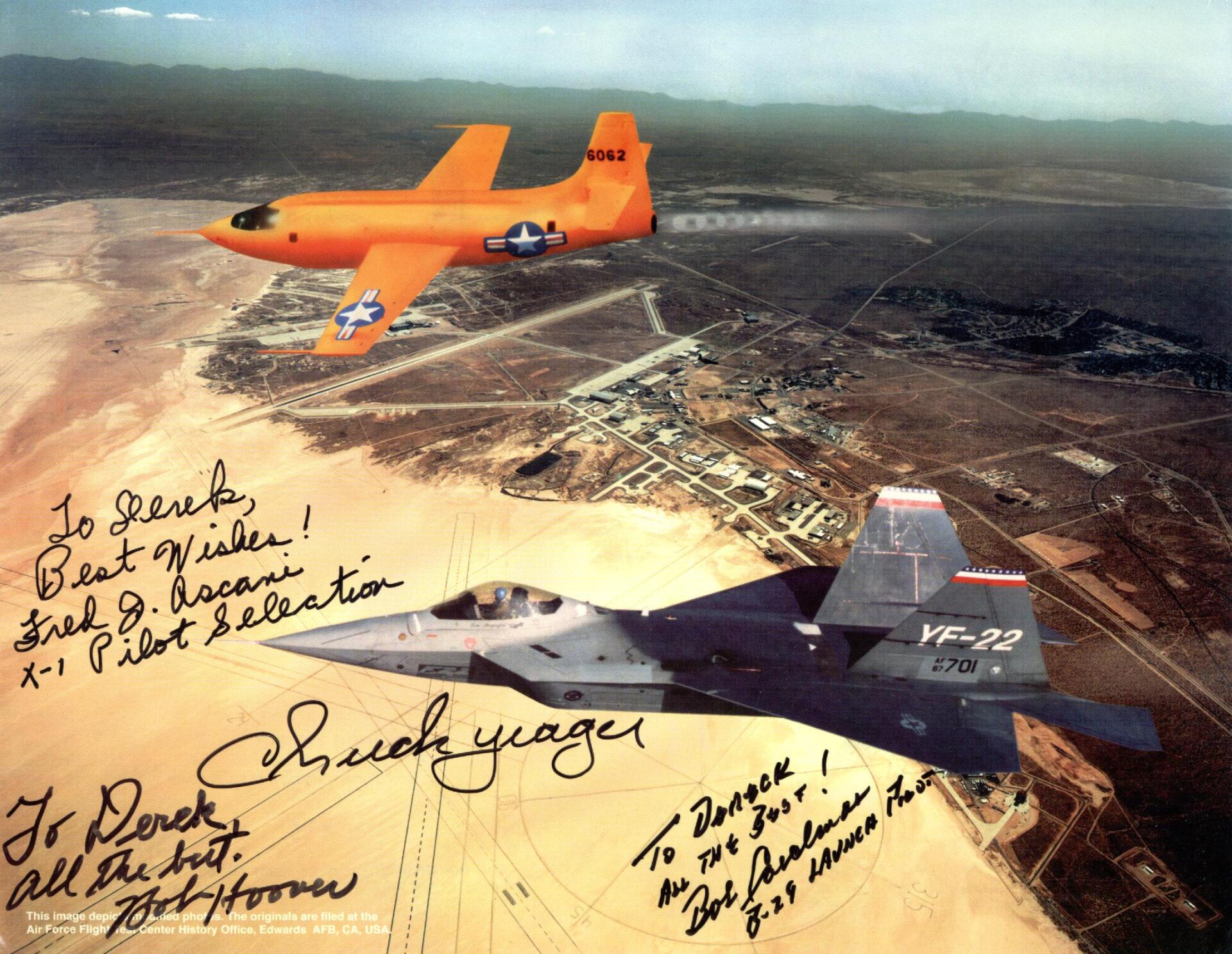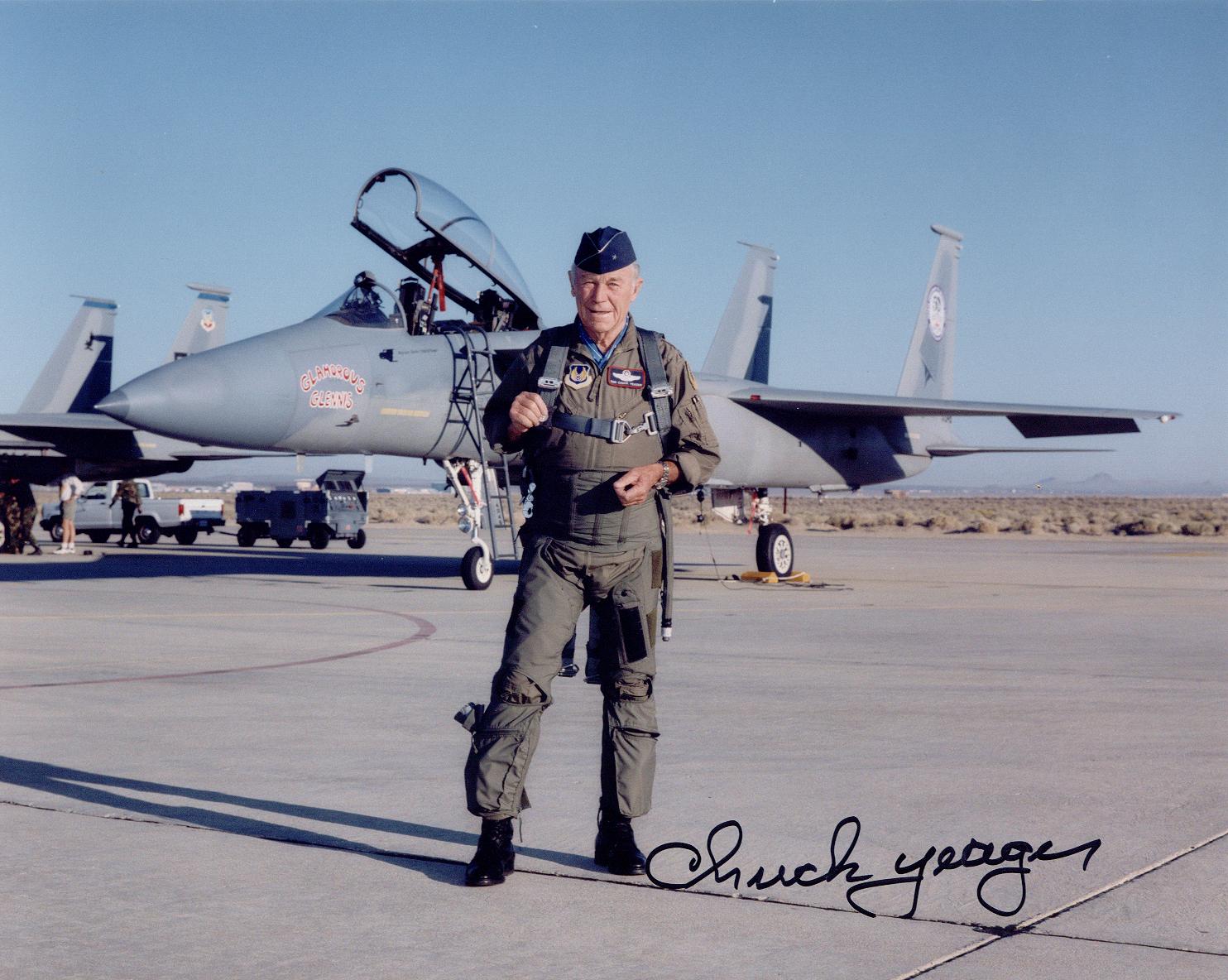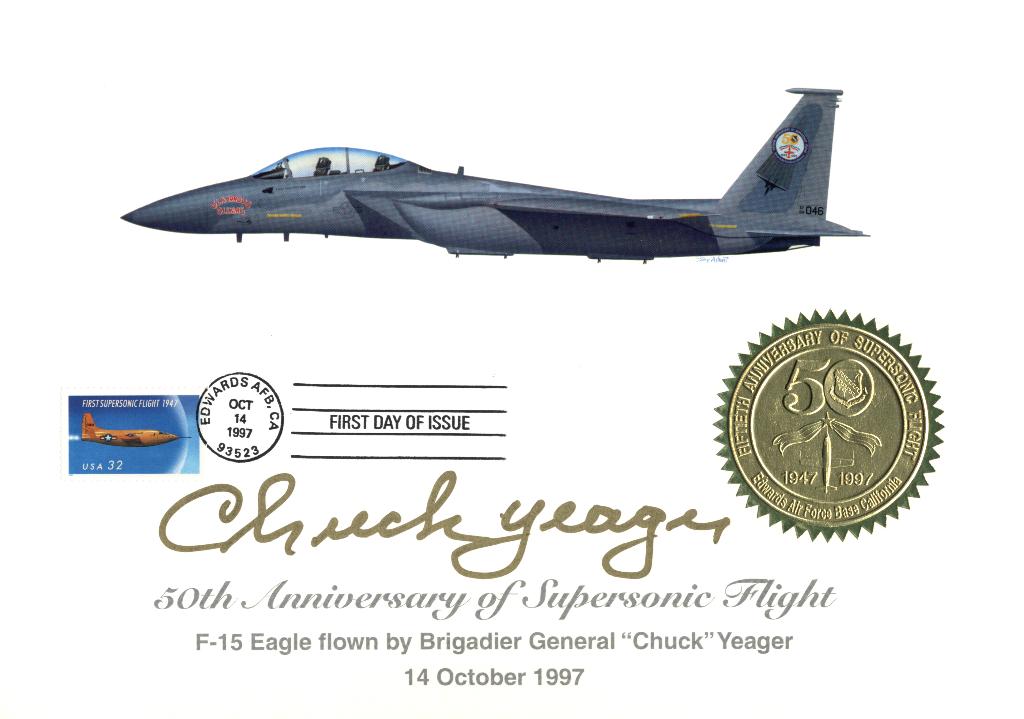Menu
Milton O. "Milt" Thompson - (1926-1993)
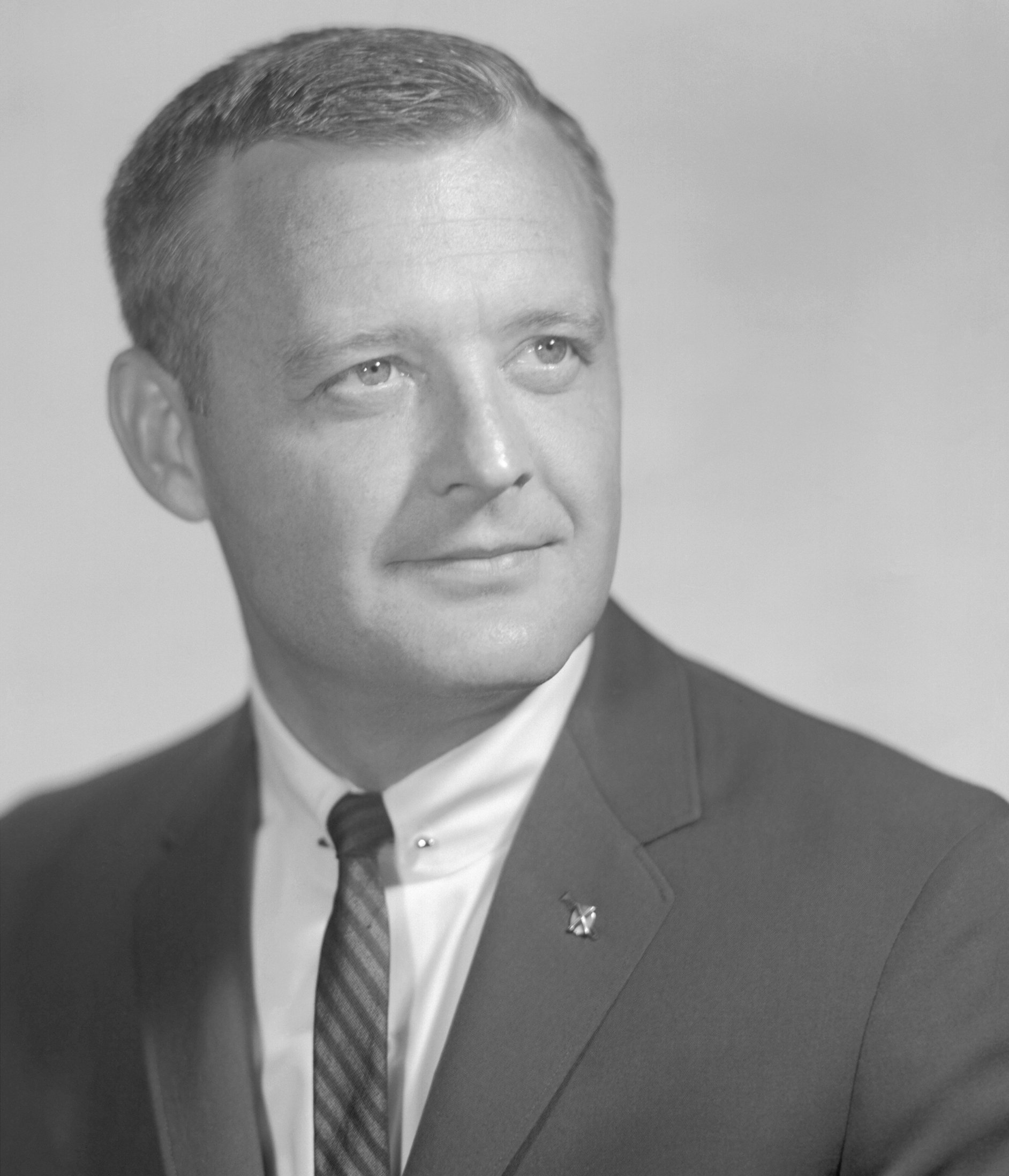
Slide title
Milt Thompson - NASA Dryden Photograph
ButtonSlide title
Gus Grissom & Milt with the Parasev
Button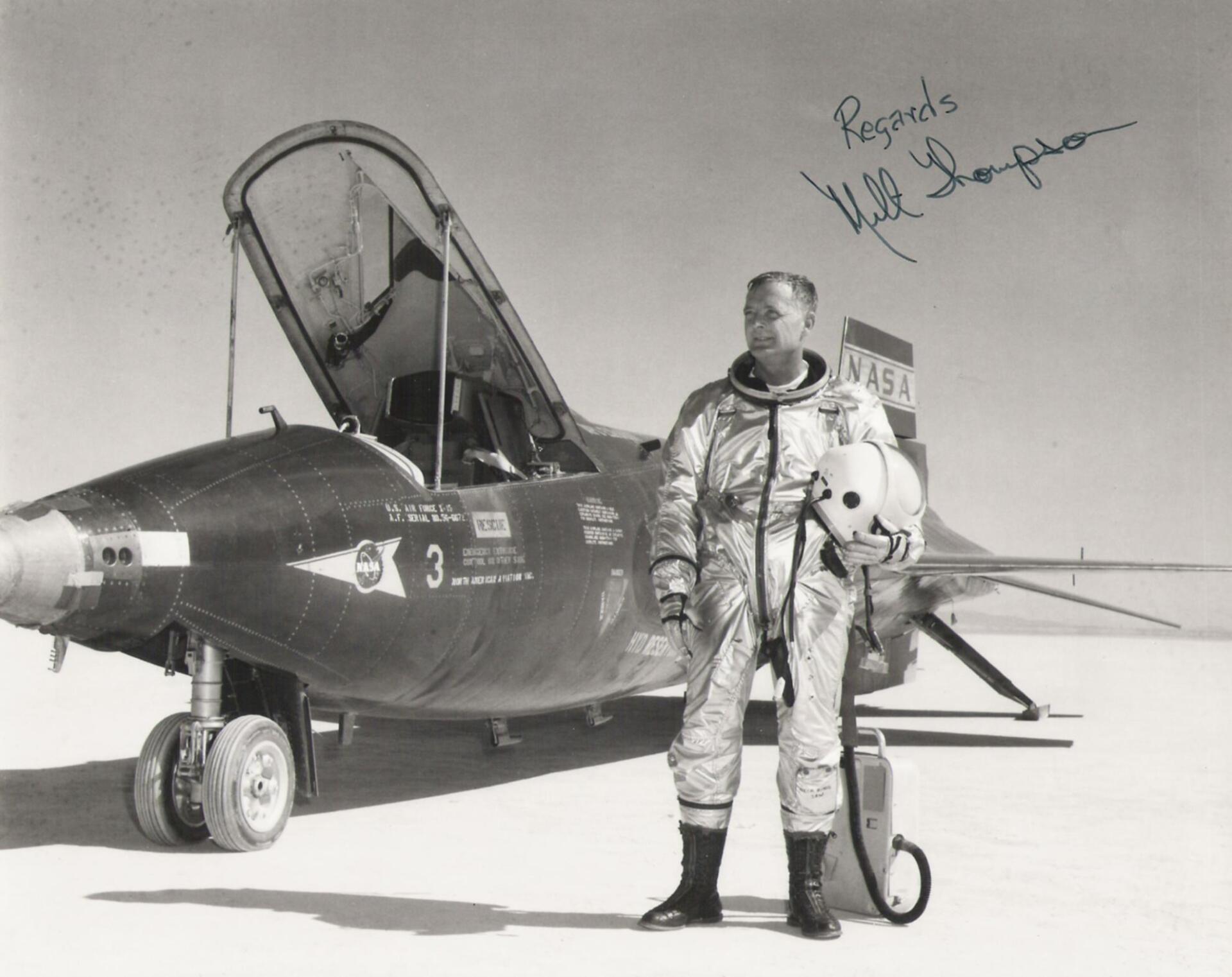
Slide title
Milt with X-15
Button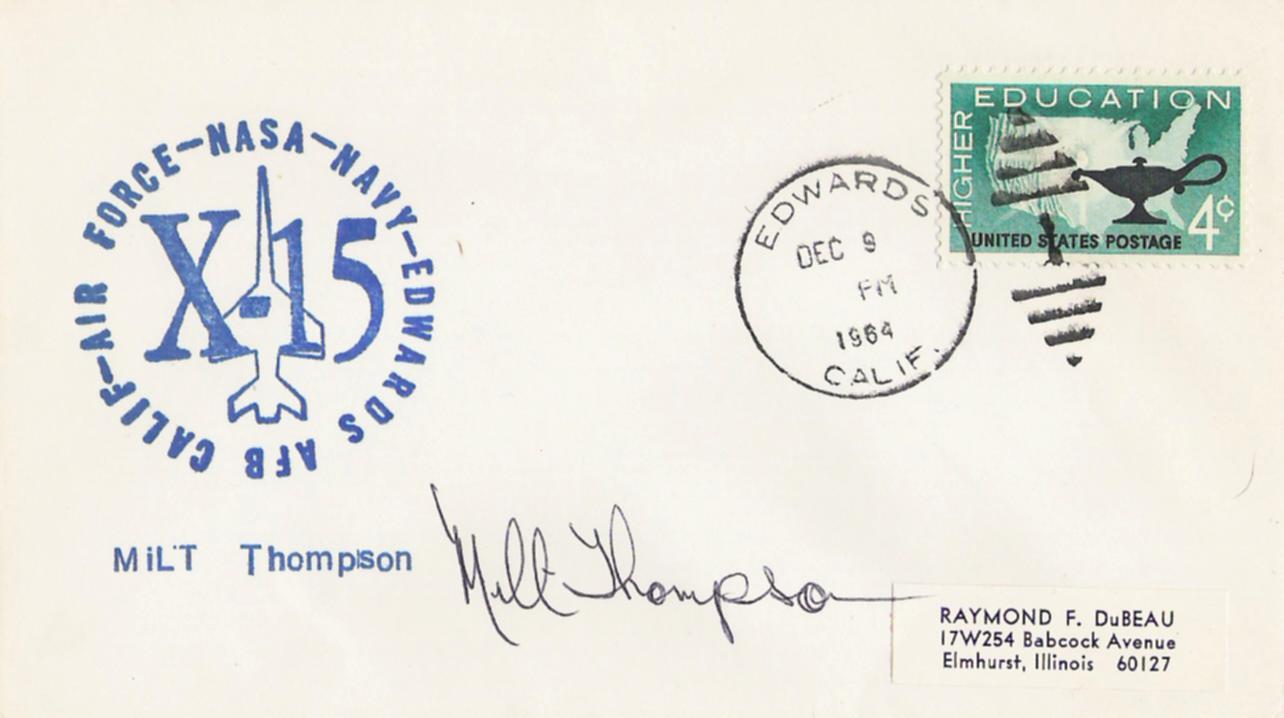
Slide title
X-15 Flight Cover - Flight #122 - Mach 5.42/3,723 mph & 92,400 ft
Button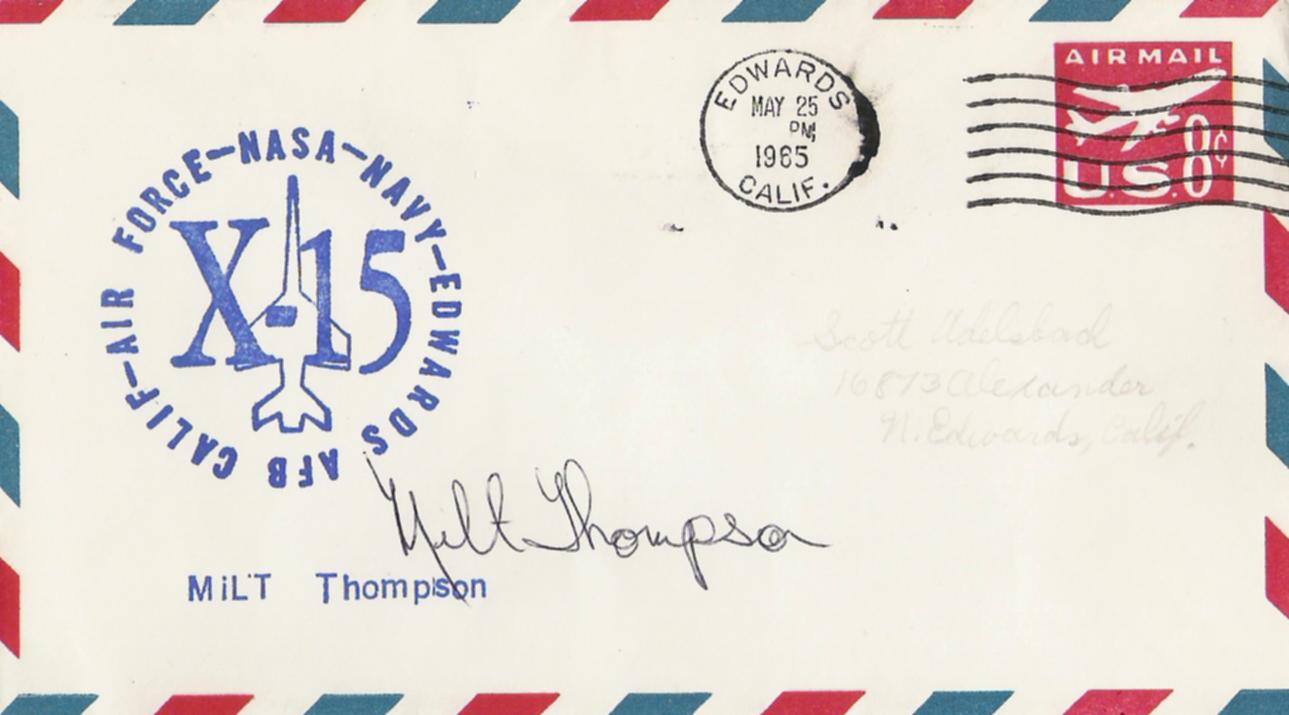
Slide title
X-15 Flight Cover - Flight #133 - Mach 4.87/3,418 mph & 179,800 ft
Button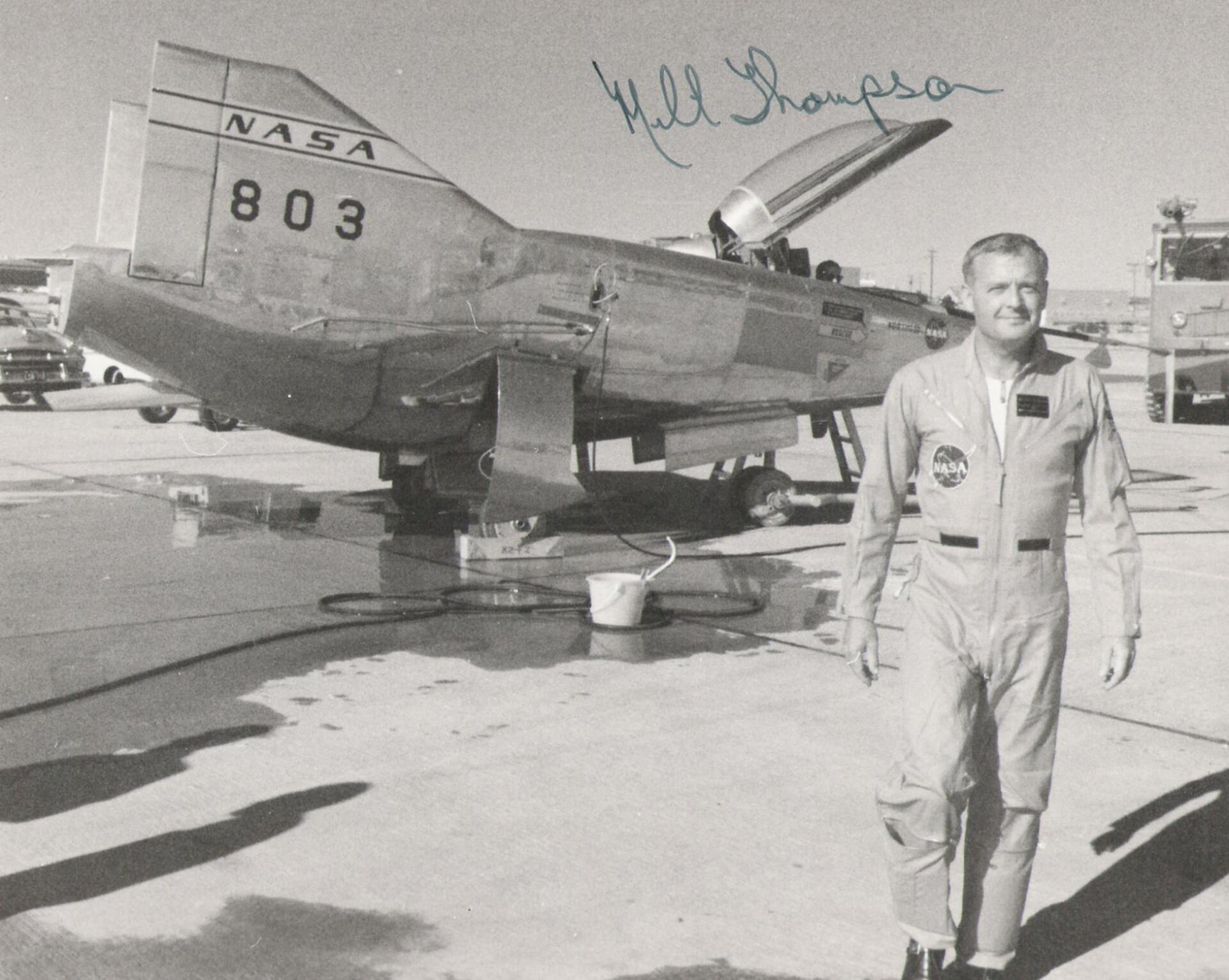
Slide title
Milt with M2-F2
Button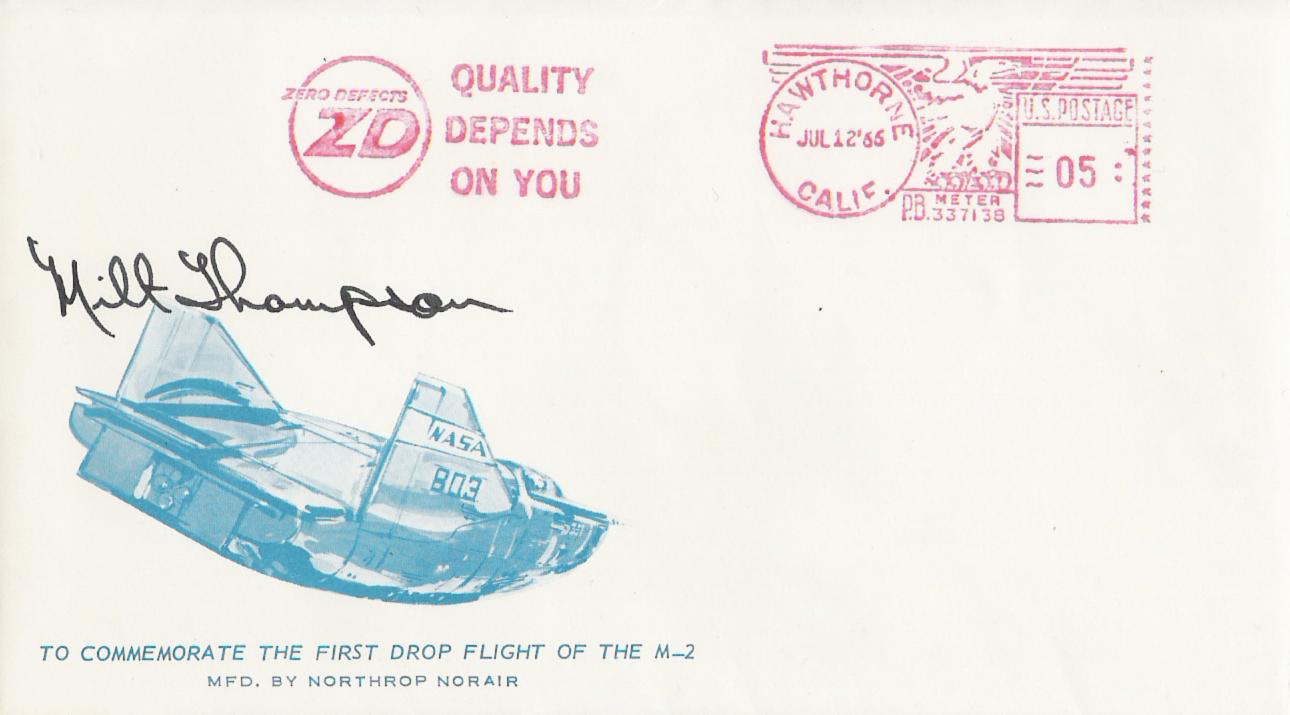
Slide title
M2-F2 First Flight cover
Button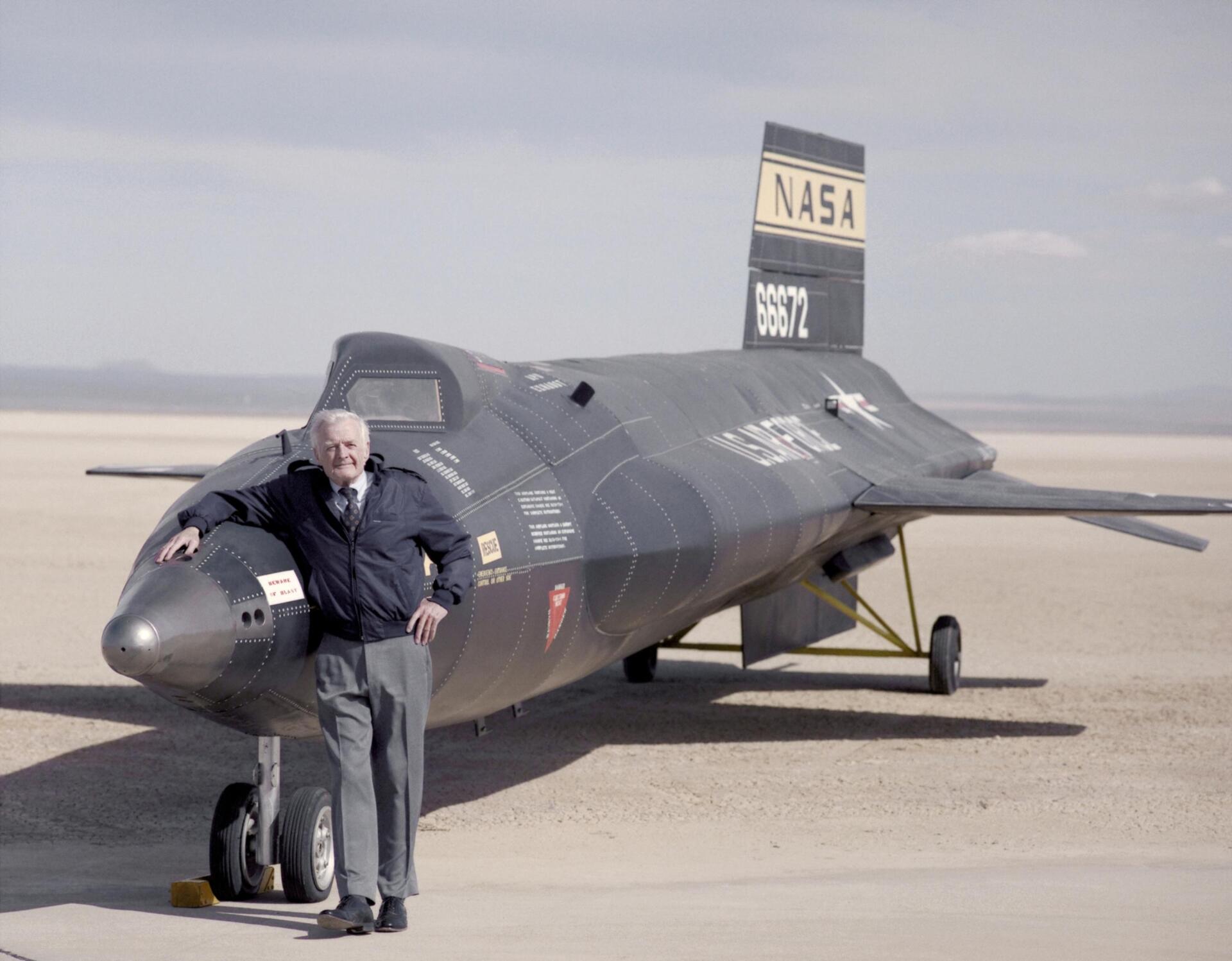
Slide title
Milt with X-15 #3 replica - NASA photo 1993
Button
Milton O. Thompson was a research pilot, Chief Engineer and Director of Research Projects during a long career at the NASA Dryden Flight Research Center. Thompson was hired as an engineer at the flight research facility on March 19, 1956, when it was still under the auspices of the NACA. He became a research pilot in January 1958. On August 16, 1963 Thompson became the first person to fly a lifting body, the lightweight M2-F1. The plywood and steel-tubing prototype was flown as a glider after releasing from an R4D tow plane. He flew it a total of 47 times, and also made the first five flights of the all-metal M2-F2 lifting body, beginning July 12, 1966. Lifting bodies were wingless vehicles designed to generate lift and aerodynamic stability from the shape of their bodies. They were flown at Dryden to study and validate the concept of safely manoeuvring and landing a low lift-over-drag vehicle designed for re-entry from space. Data from the program helped in the development of the Space Shuttles.
Thompson was also one of the 12 NASA, Air Force, and Navy pilots to fly the X-15 rocket-powered research aircraft between 1959 and 1968. He began flying X-15s on October 29, 1963, only a couple months after his first Lifting Body flight. He flew the aircraft 14 times during the following two years, reaching a maximum speed of 3712 mph (Mach 5.48) and a peak altitude of 214,100 feet on separate flights. The X-15 program provided a wealth of data on aerodynamics, thermodynamics, propulsion, flight controls, and the physiological aspects of high-speed, high-altitude flight. In 1962, Thompson was selected by the Air Force to be the only civilian test pilot to fly in the X-20 Dyna-Soar program that was intended to launch a human into Earth orbit and recover with a horizontal ground landing. The program was cancelled before construction of the vehicle began.
Thompson concluded his active flying career in 1967, becoming Chief of Research Projects two years later. In 1975 he was appointed Chief Engineer and retained the position until his death on August 6, 1993. Thompson was also a member of NASA's Space Transportation System Technology Steering Committee during the 1970s. In this role he was successful in leading the effort to design the Orbiters for power-off landings rather than increase weight with air-breathing engines for airliner-type landings. His committee work earned him NASA's highest award, the Distinguished Service Medal. Born in Crookston, Minn., on May 4, 1926, Thompson began flying with the U.S. Navy as a pilot trainee at the age of 19. He subsequently served during World War II with duty in China and Japan.
Following six years of active naval service, Thompson entered the University of Washington, in Seattle, Wash. He graduated in 1953 with a Bachelor of Science degree in Engineering. He remained in the Naval Reserves during college, and continued flying--not only naval aircraft but crop dusters and forest-spraying aircraft. After college graduation, Thompson became a flight test engineer for the Boeing Aircraft Company in Seattle. During his two years at Boeing, he flew on the sister aircraft of Dryden's B-52B air-launch vehicle. Thompson was a member of the Society of Experimental Test Pilots, and received the organization's Iven C. Kincheloe trophy as the Outstanding Experimental Test Pilot of 1966 for his research flights in the M2 lifting bodies. He also received the 1967 Octave Chanute award from the American Institute of Aeronautics and Astronautics for his lifting-body research. In 1990, the National Aeronautics Association selected Thompson as one of the year's recipients of its Elder Statesman of Aviation awards. The awards have been presented each year since 1955 to individuals for contributions "of significant value over a period of years" in the field of aeronautics. Thompson wrote several technical papers, was a member of NASA's Senior Executive Service, and received several NASA awards.
Milt Thompson sadly passed away on 6th August 1993. For further reading I highly recommend Milt Thompson's "At the Edge of Space: The X-15 Flight Program" & "Flying Without Wings: NASA Lifting Bodies and the Birth of The Space Shuttle".
Brigadier General Robert F. "Bob" Titus(USAF ret)
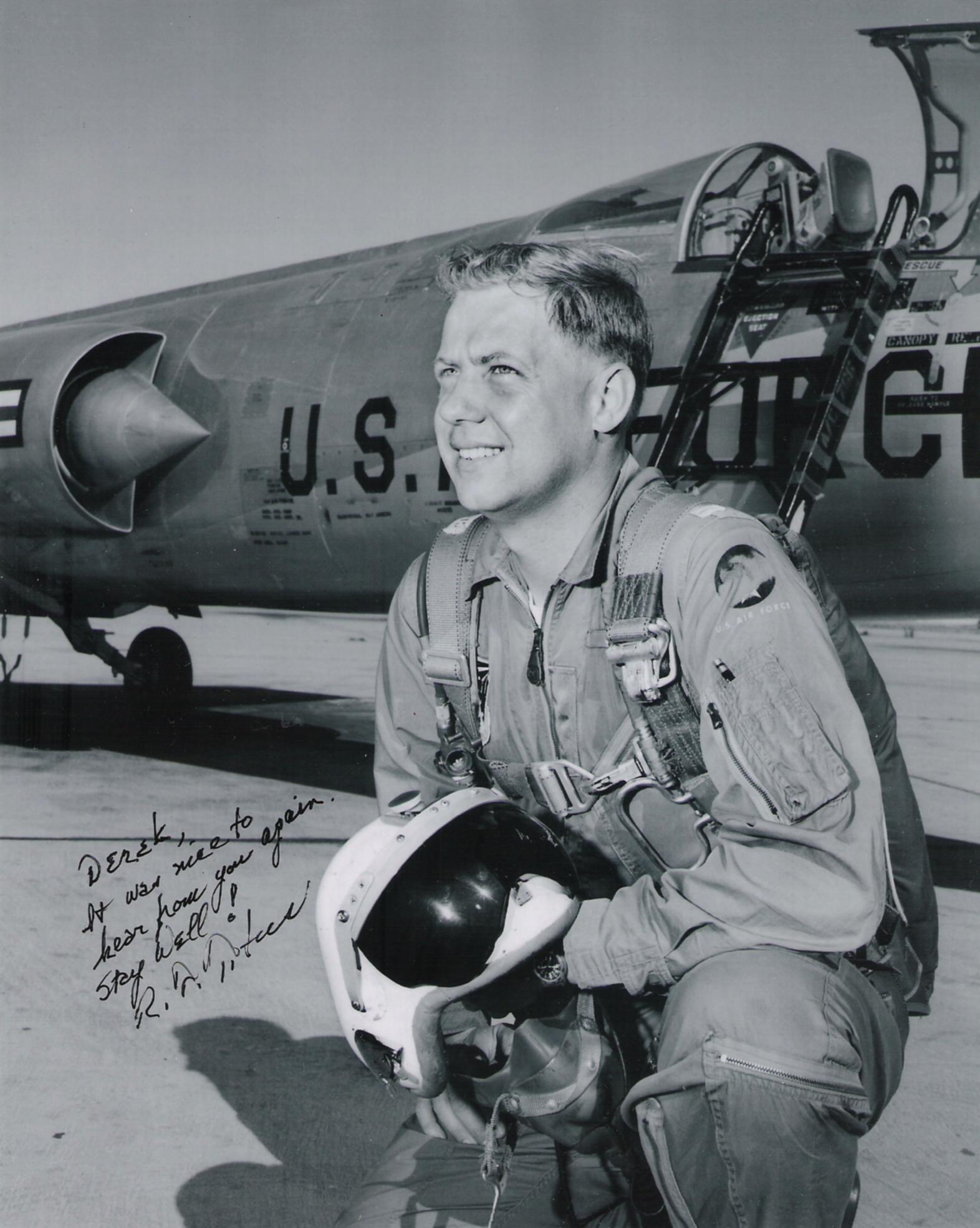
Slide title
Bob Titus with F-104
Button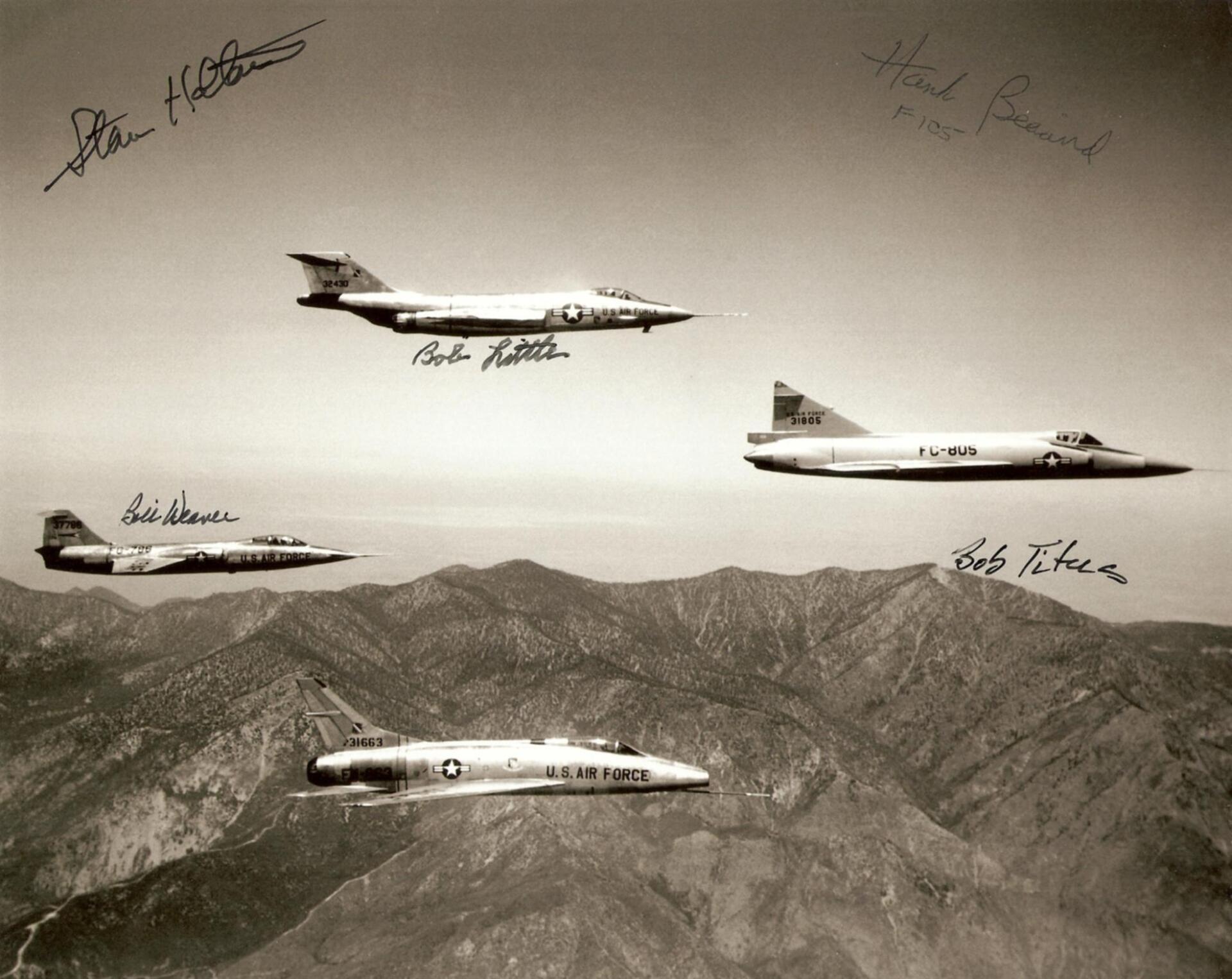
Slide title
Century Series Fighters - F-100, F-101, F-102 & F-104
ButtonSlide title
F-100 ZEL - Zero Length Launch
Button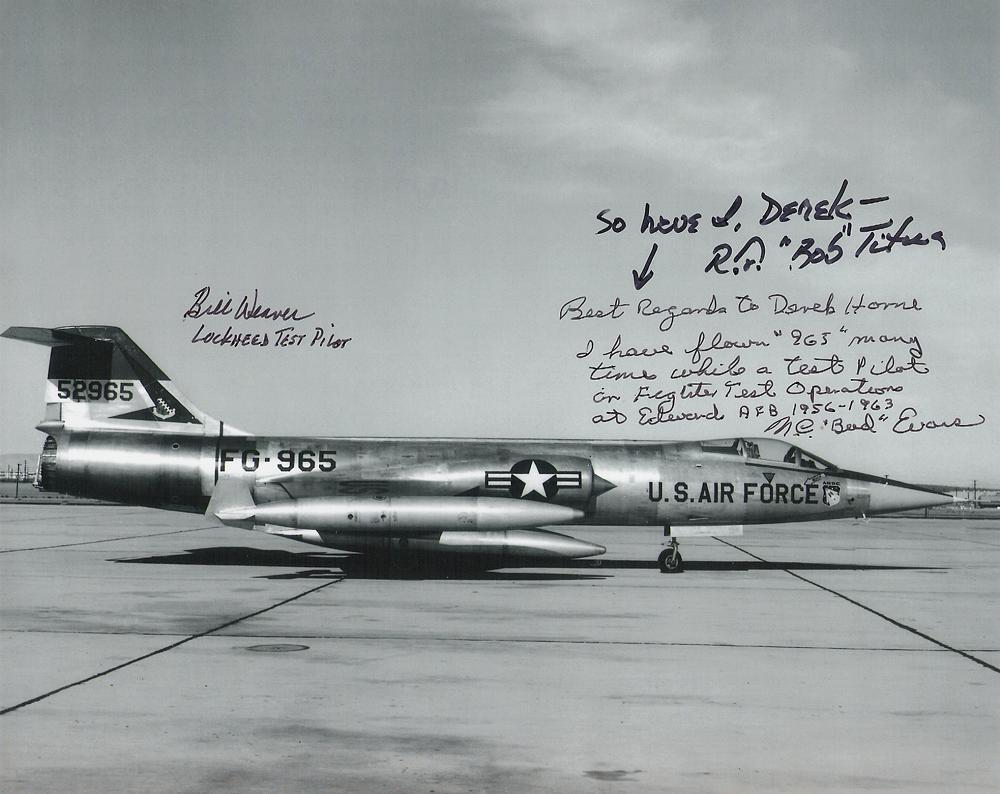
Slide title
F-104
Button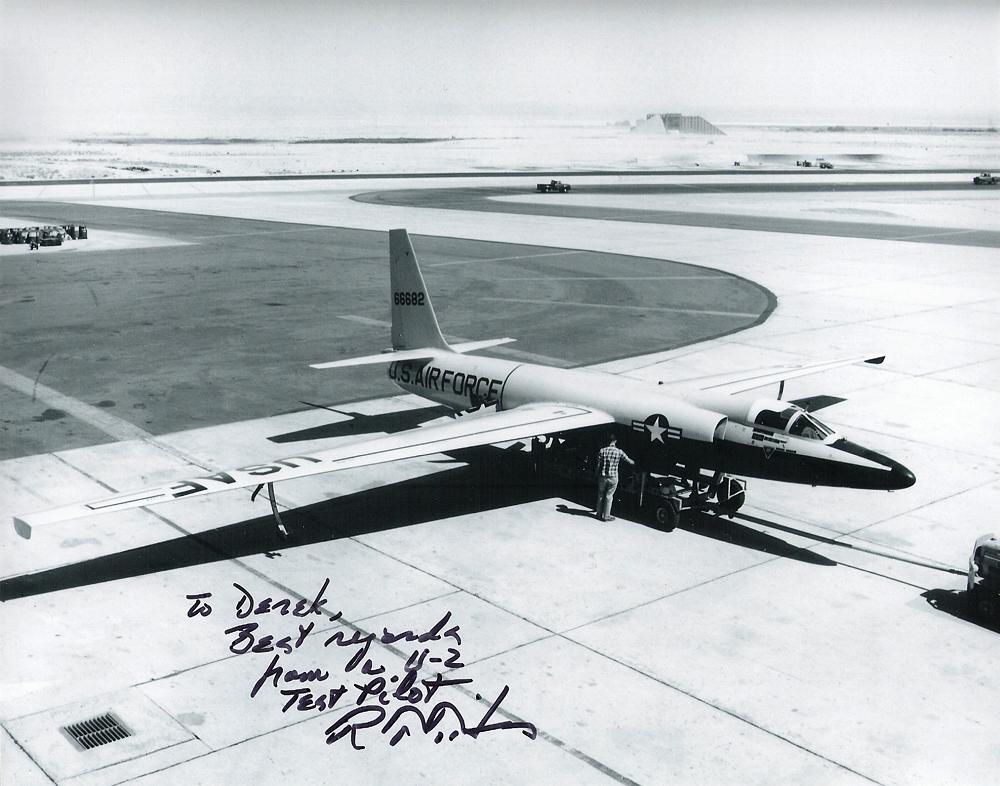
Slide title
U-2
Button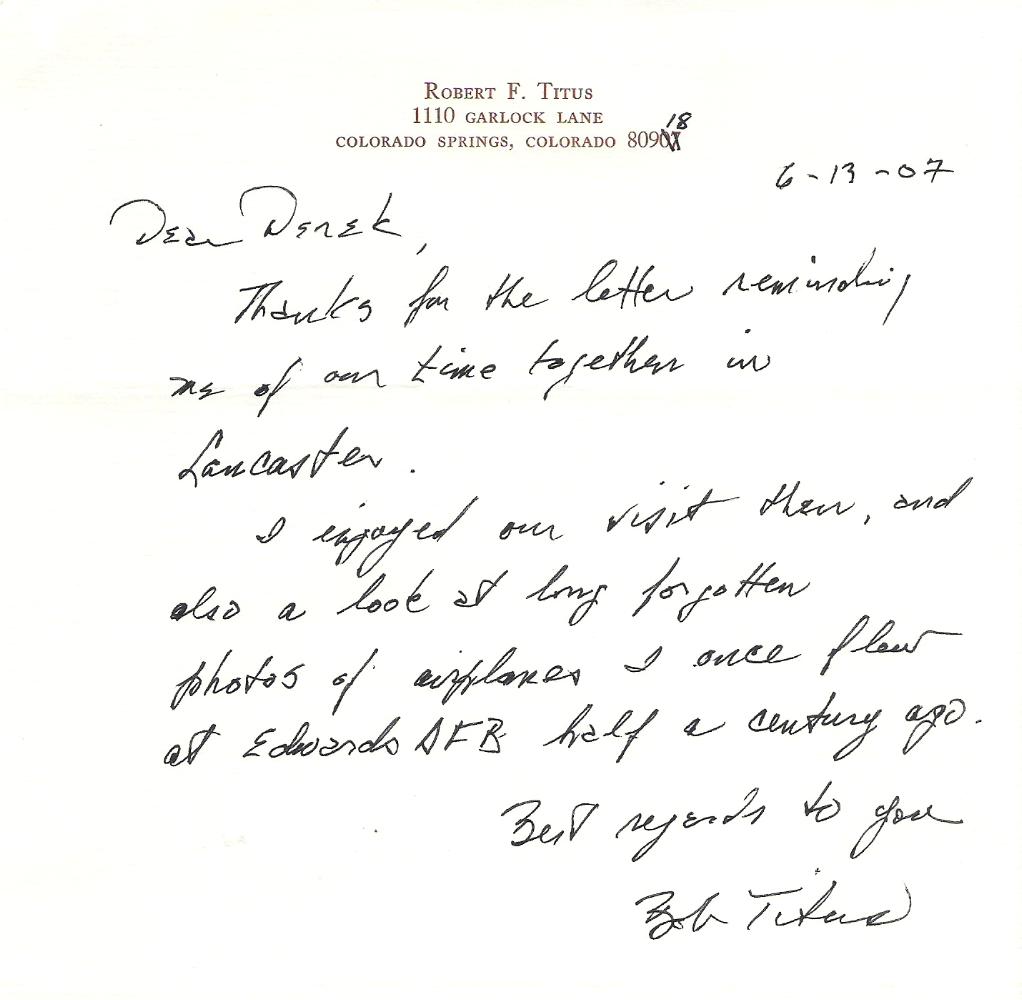
Slide title
Letter I received from General Titus
Button
General Titus is a combat veteran of both the Korean war and Vietnam war flying 101 combat missions in the former. General Titus spent 6 years at Edwards AFB as a test pilot and flew amongst other aircraft the F-100ZEL or Zero Length Launch program making one flight (which Titus confirmed was more than enough!!). The F-100ZEL was propelled from rest to flying speed by a rocket powered launch module providing some 300,000 Ibs of thrust! General Titus also tested and flew the U-2, F-101, F-102, F-104 and F-105 while stationed at Edwards AFB. Read General Titus Air Force biography and also his biography from the 1998 "Gathering of Eagles". General Titus was honored by the Flight Test Historical Foundation in October 2003.
Joseph A. "Joe" Walker

Slide title
Joe Walker with X-1E
Button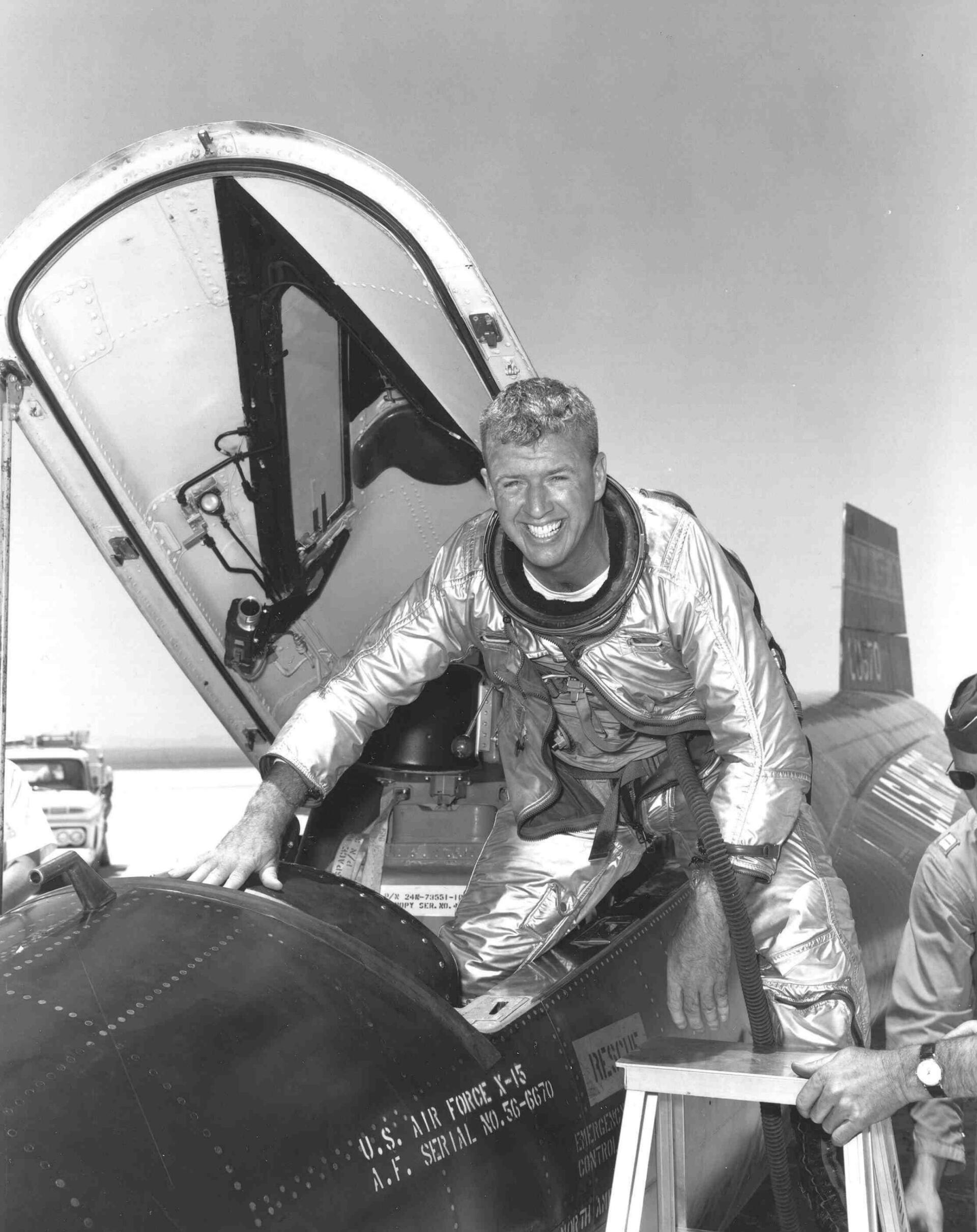
Slide title
Joe Walker with X-15
Button
Slide title
Joe Walker with X-15
Button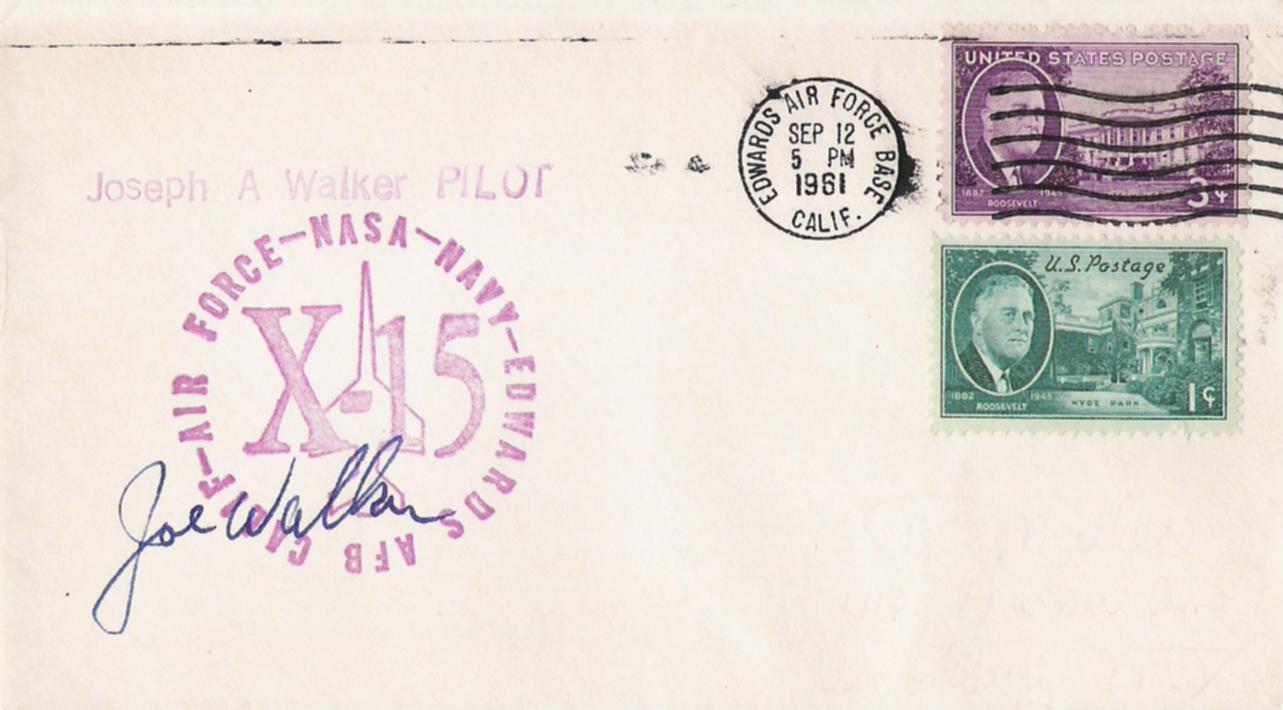
Slide title
X-15 Flight Cover - Flight #40 - Mach 5.21/3,618 mph & 114,300 ft
Button
Walker was born February 20, 1921, in Washington, Pa. He lived there until graduating from Washington and Jefferson College in 1942, with a B.A. degree in Physics. During World War II he flew P-38 fighters for the Air Force, earning the Distinguished Flying Cross and the Air Medal with Seven Oak Clusters.
Joseph A. Walker was a Chief Research Pilot at the NASA Dryden Flight Research Center during the mid-1960s. He joined the NACA in March 1945, and served as project pilot at the Edwards flight research facility on such pioneering research projects as the D-558-1, D-558-2, X-1, X-3, X-4, X-5, and the X-15. He also flew programs involving the F-100, F-101, F-102, F-104, and the B-47.
Walker made the first NASA X-15 flight on March 25, 1960. He flew the research aircraft 24 times and achieved its fastest speed and highest altitude. He attained a speed of 4,104 mph (Mach 5.92) during a flight on June 27, 1962, and reached an altitude of 354,300 feet on August 22, 1963 (his last X-15 flight). He was the first man to pilot the Lunar Landing Research Vehicle (LLRV) that was used to develop piloting and operational techniques for lunar landings.
Walker was the recipient of many awards during his 21 years as a research pilot. These include the 1961 Robert J. Collier Trophy, 1961 Harmon International Trophy for Aviators, the 1961 Kincheloe Award and 1961 Octave Chanute Award. He received an honorary Doctor of Aeronautical Sciences degree from his alma mater in June of 1962. Walker was named Pilot of the Year in 1963 by the National Pilots Association.
He was a charter member of the Society of Experimental Test Pilots, and one of the first to be designated a Fellow. He was fatally injured on June 8, 1966, in a mid-air collision between an F-104 he was piloting and the XB-70.
Alvin S. "Al" White - (1918-2006)
Slide title
Al White with XB-70 Ejection Seat
Button
Slide title
XB-70 First Flight Pilots - Joe Cotton & Al White
Button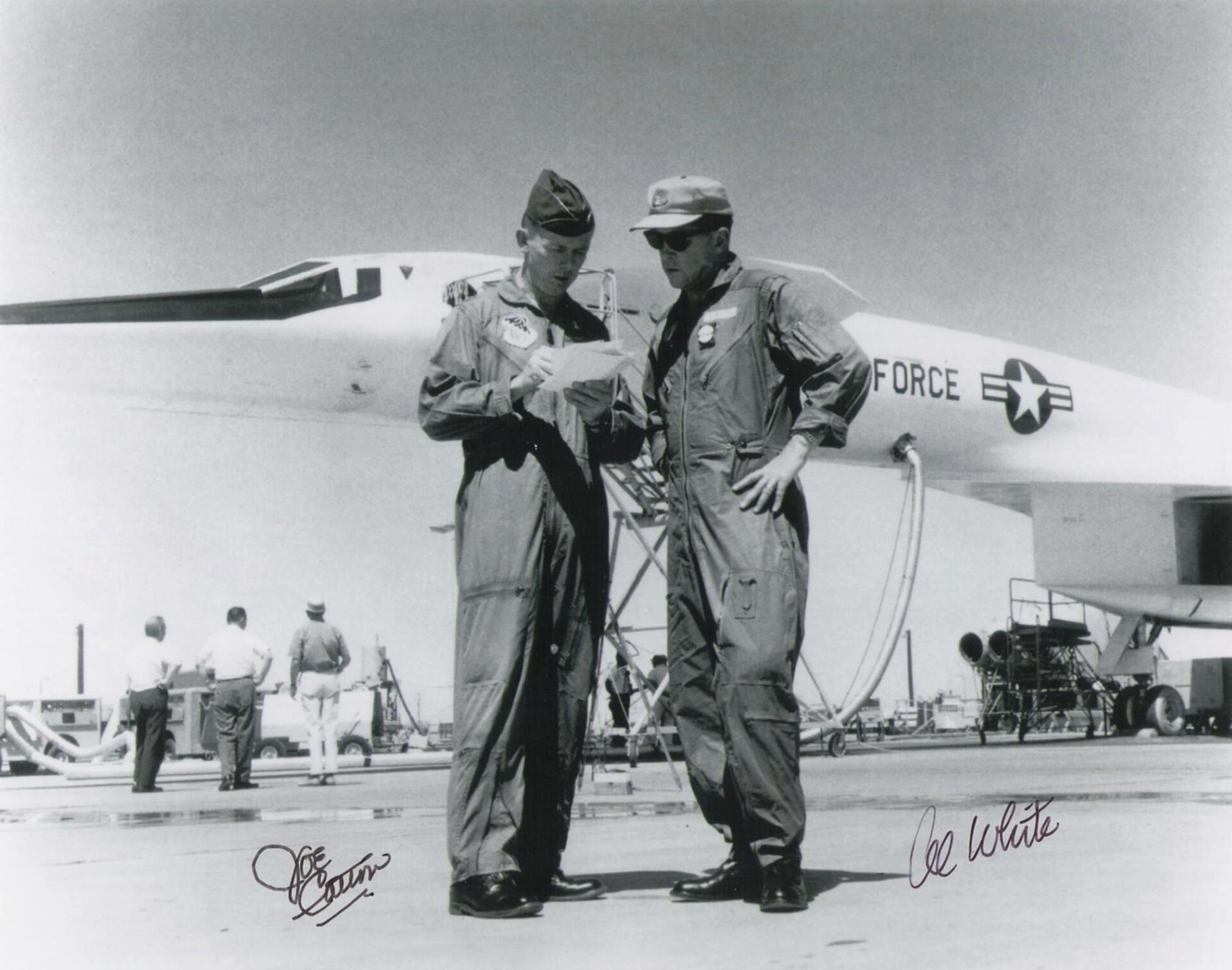
Slide title
Joe & Al with XB-70
Button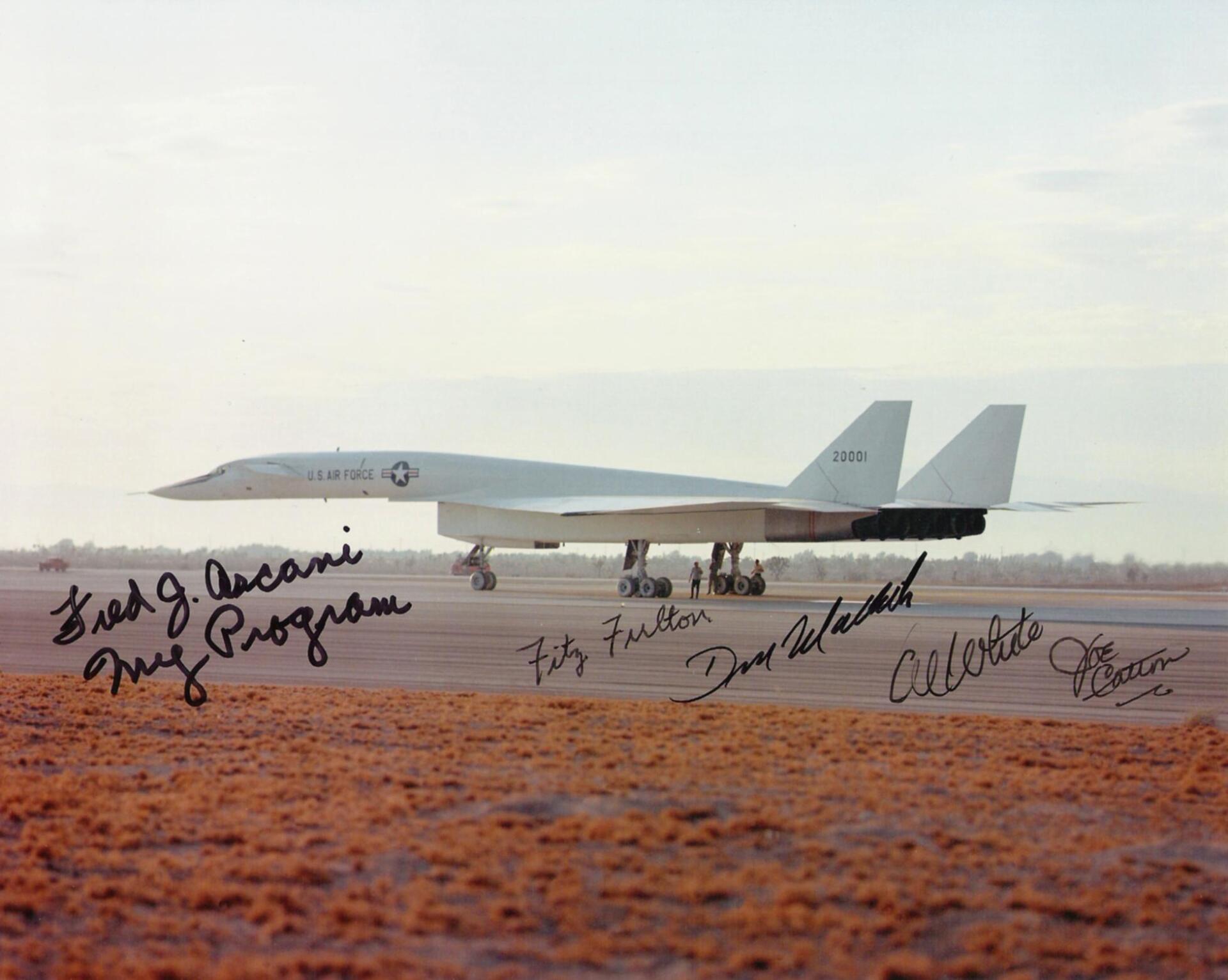
Slide title
XB-70 Multi-Signed
Button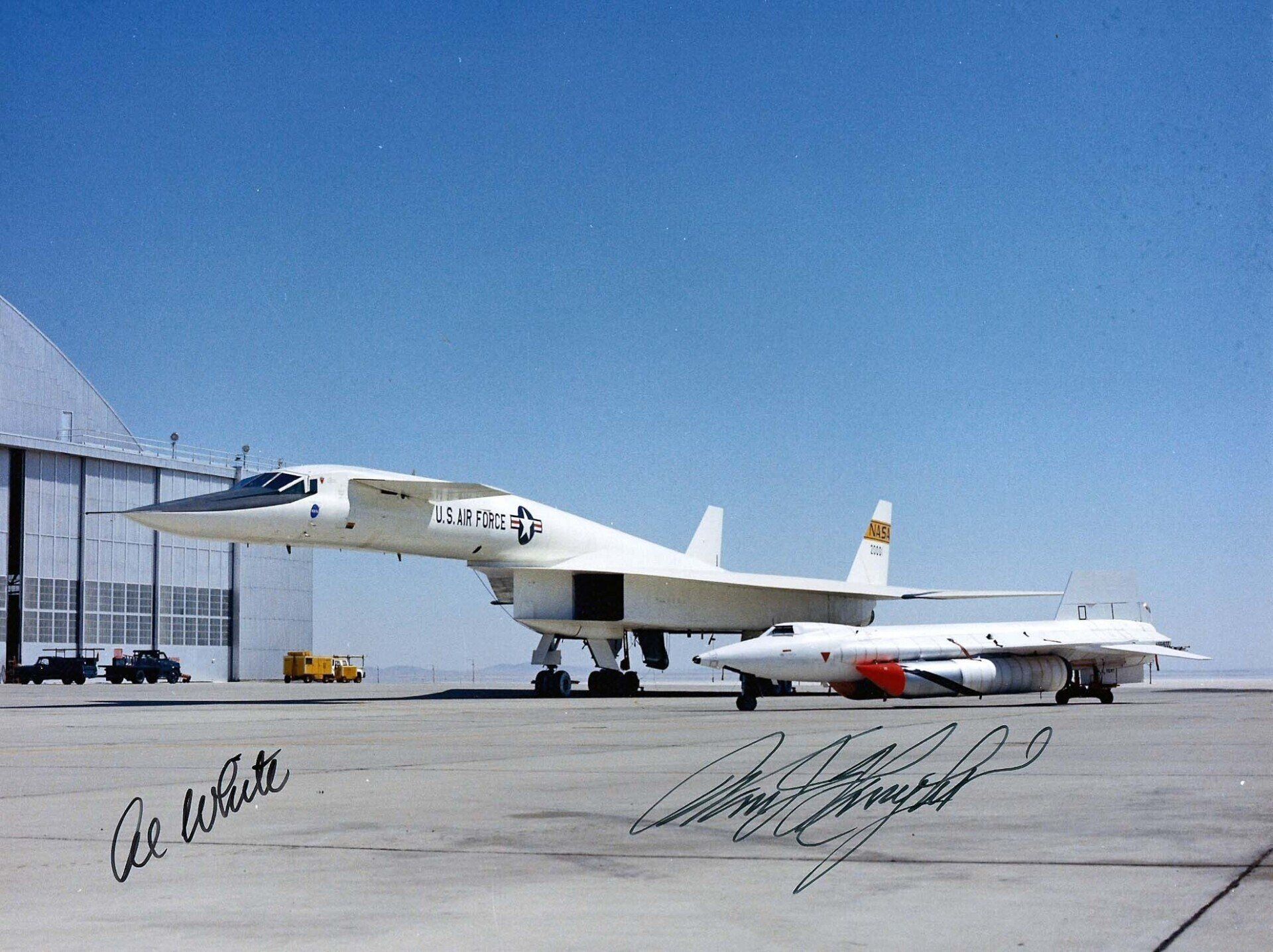
Slide title
XB-70 & X-15-A2 signed by Al White & Pete Knight
Button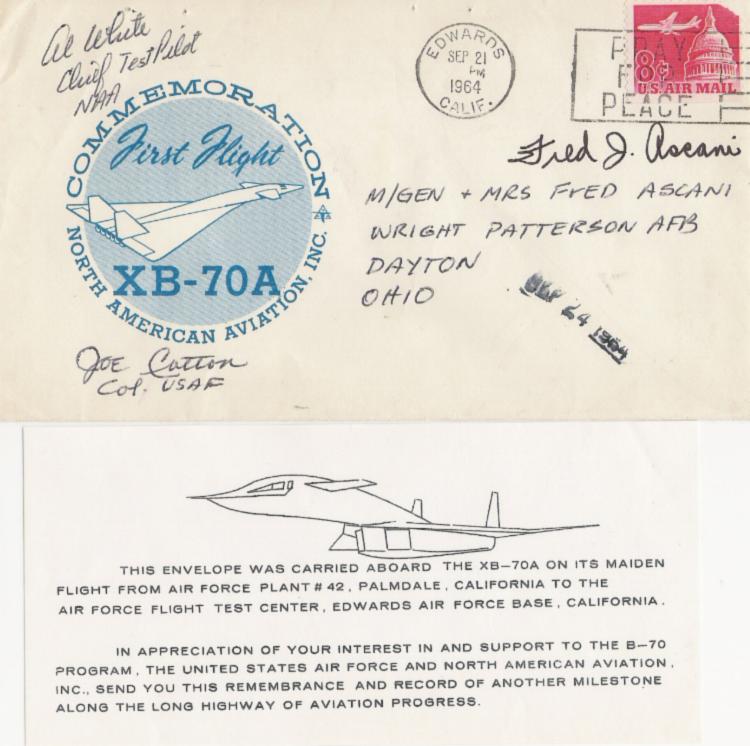
Slide title
Flown XB-70 first flight cover
ButtonSlide title
The Author with Al White & Joe Cotton - Lancaster, CA 2003
Button
Al White was a combat fighter pilot in WWII, flying P-51's with the 355th FG in the European Theatre of Operations. He served as Assistant Project Engineer at the Parachute Research Unit at Wright-Patterson AFB and later at El Centro. Following his graduation from the Experimental Test Pilot School in Class 52a, then Captain White was assigned to Flight Test Operations at the Air Force Flight Test Center at Edwards AFB. White was project pilot on the F-89D and the E-6 Fire Control System development. In his final year of active duty, he served as the Assistant Chief of Fighter Test Operations at the AFFC. White joined North American Aviation in 1954 as an engineering test pilot and was the Assistant Project Pilot for the contractor phase of flight testing the X-15. In 1961 was appointed chief test pilot and flew the first flights of the prototype F-100C and F-100F aircraft. White conducted the Mach 2 stores drop demonstration and zoom climb program in the F-107. As North American's Chief Project Pilot for the XB-70, White flew the first flights of both XB-70 aircraft, the first 2,000 mph flight and subsequent Mach 3 exploratory flights. White was severely injured after ejecting from the XB-70 when Joe Walker's F-104 collided with the tail of the Valkyrie on June 6th, 1966. For more information on the XB-70 click here . Al White sadly passed away on April 29th, 2006.
Maj. Gen. Robert M. "Bob" White USAF - (1924-2010)
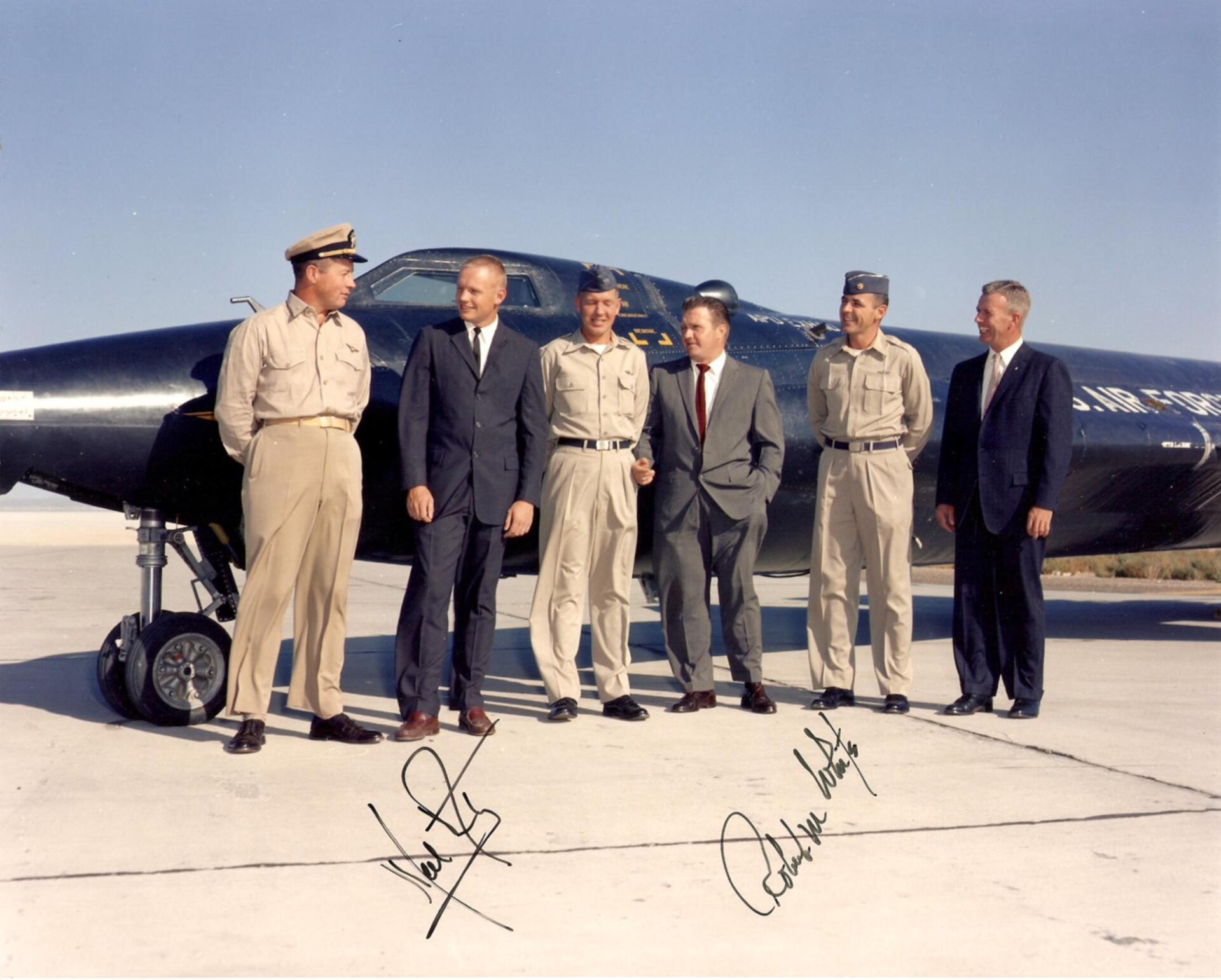
Slide title
X-15 pilots Petersen, Armstrong, Rushworth, McKay, White & Walker
Button
Slide title
Fastest flight of the X-15 with LR-11 engines
Button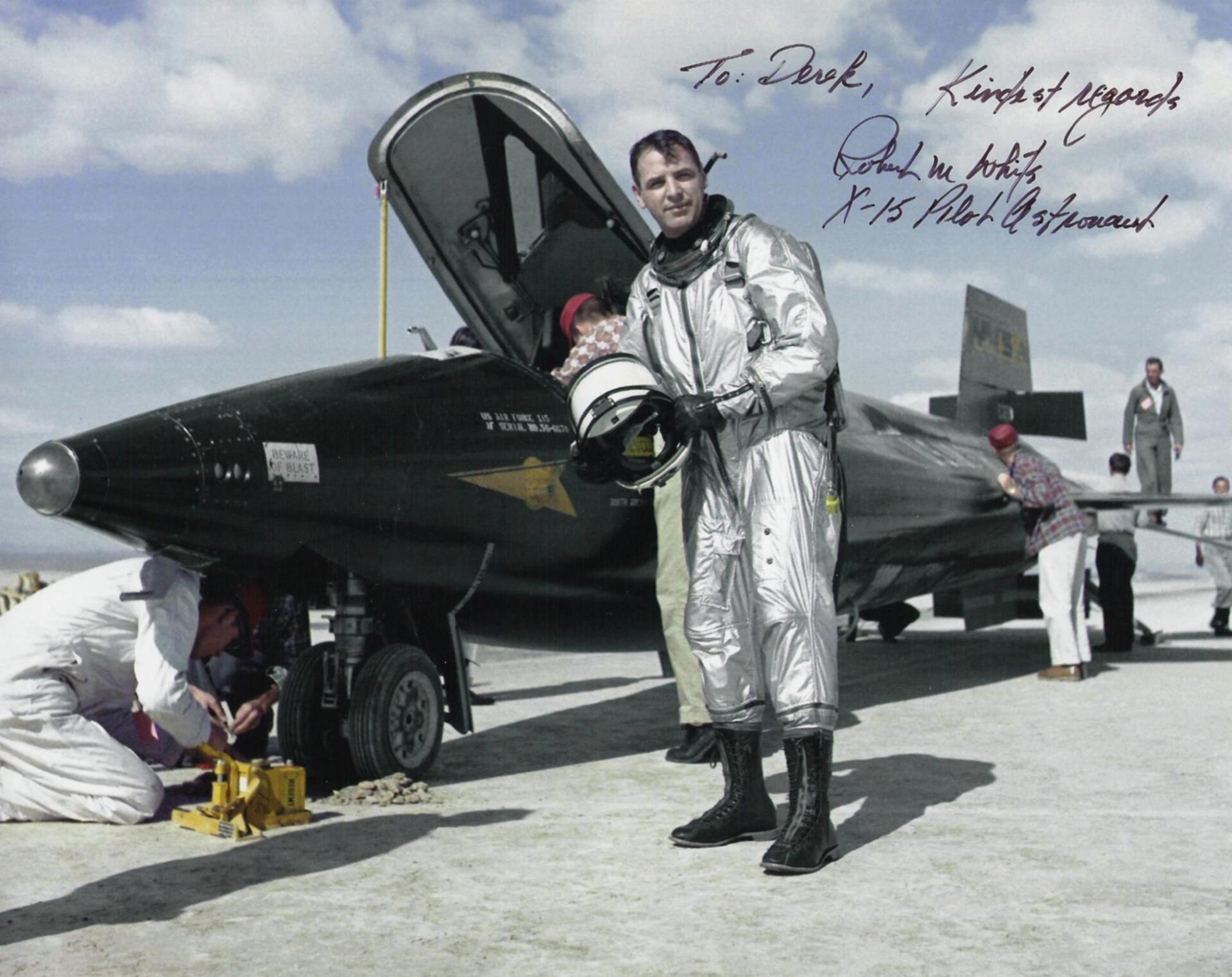
Slide title
Bob White with the X-15
Button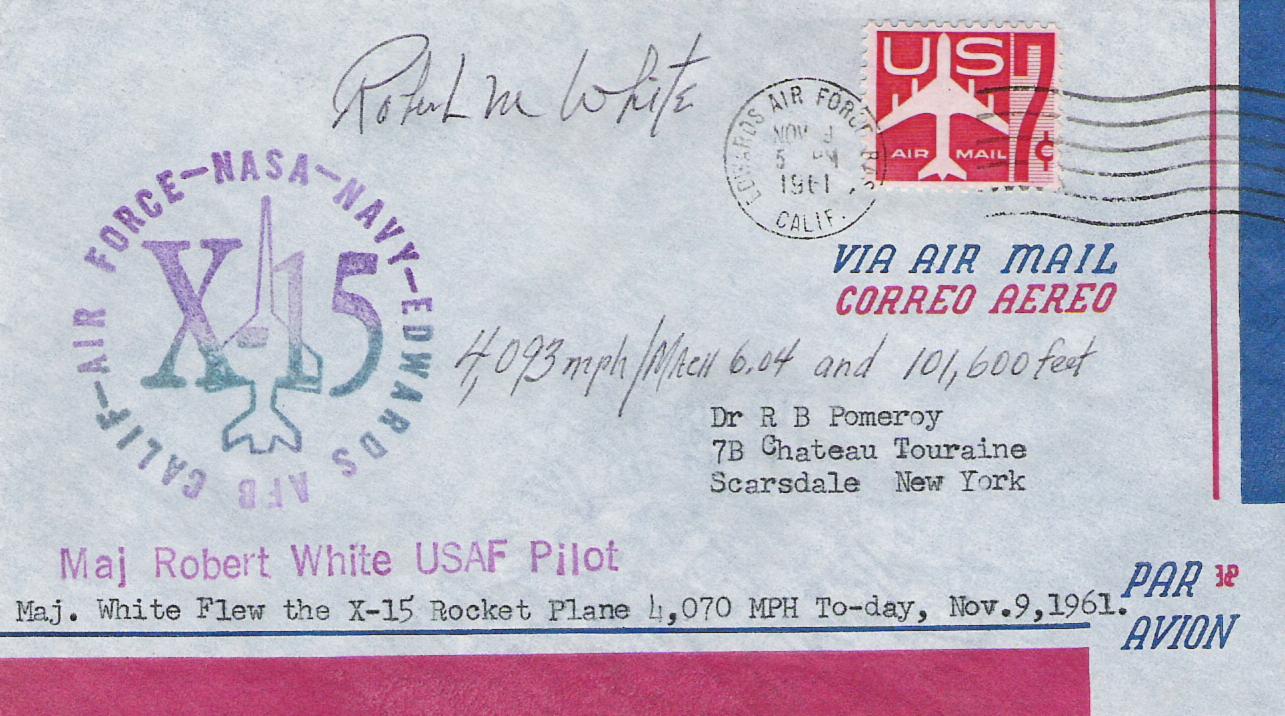
Slide title
X-15 Flight Cover - Flight #45 - Mach 6.04/4,093 mph & 101,600 ft - FIRST Mach 6 Flight
Button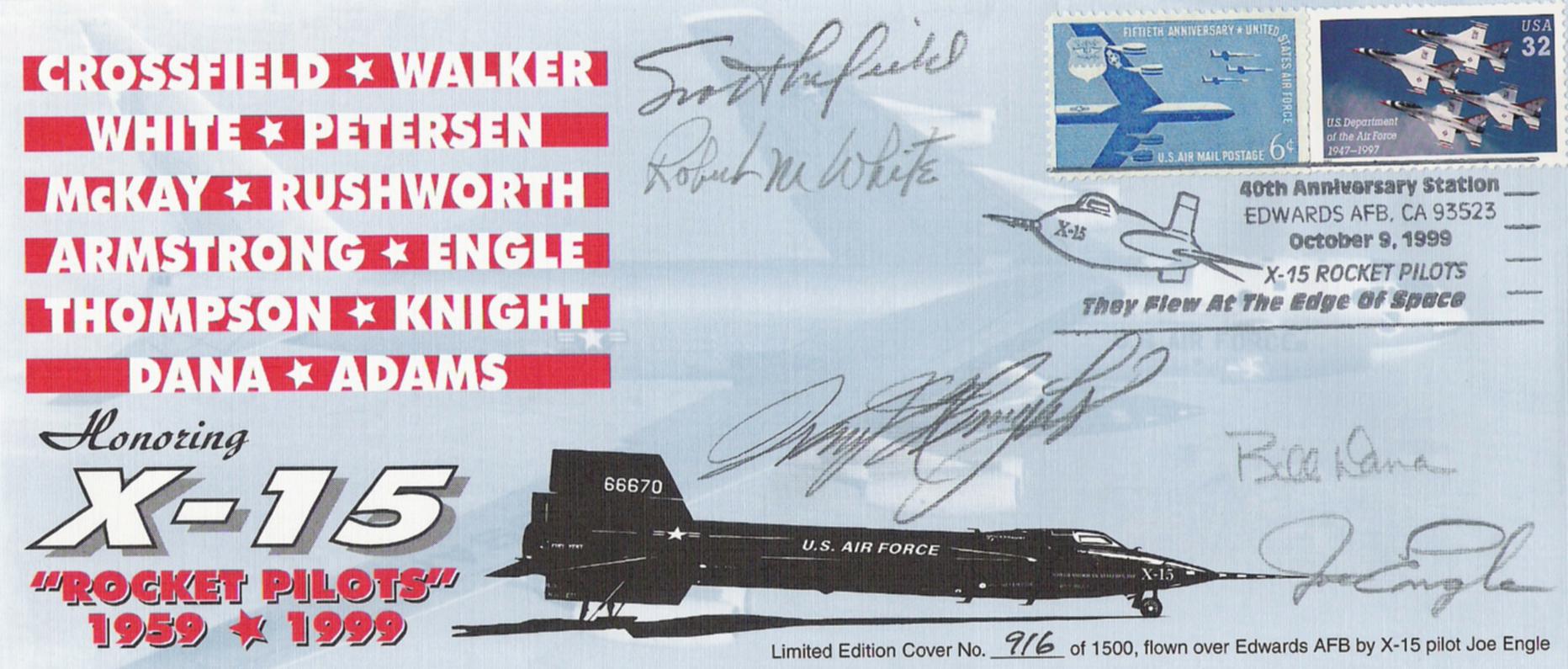
Slide title
Anniversary cover signed by X-15 pilots Crossfield, Dana, Engle, Knight & White
Button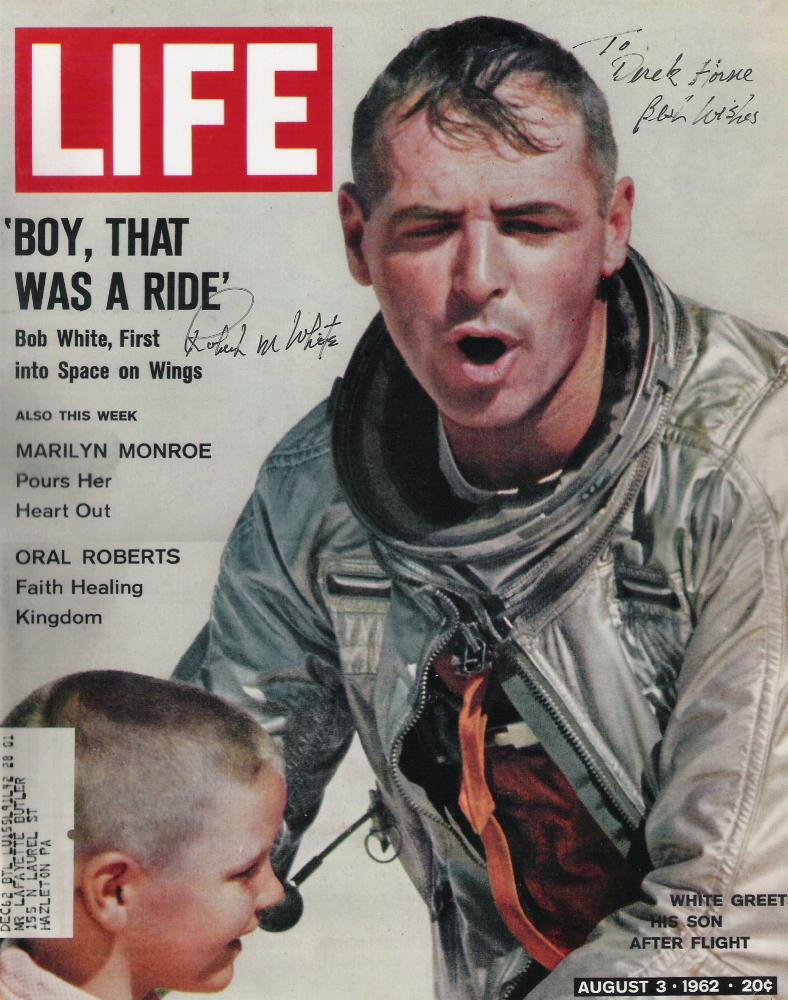
Slide title
Bob greets his 7 yr old son Greg after the first X-15 flight above 50 miles - 314,750 ft
Button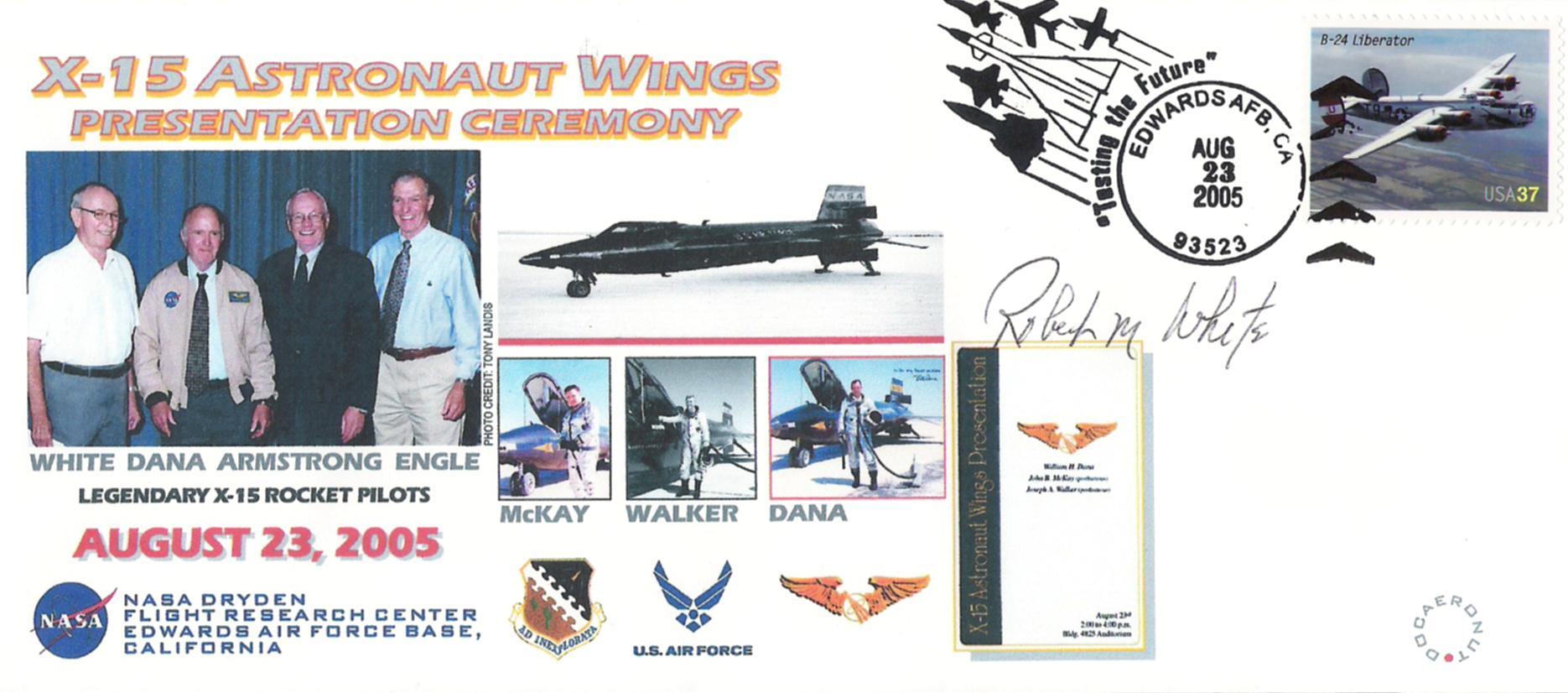
Slide title
Astronaut Wings Presentation Ceremony cover
Button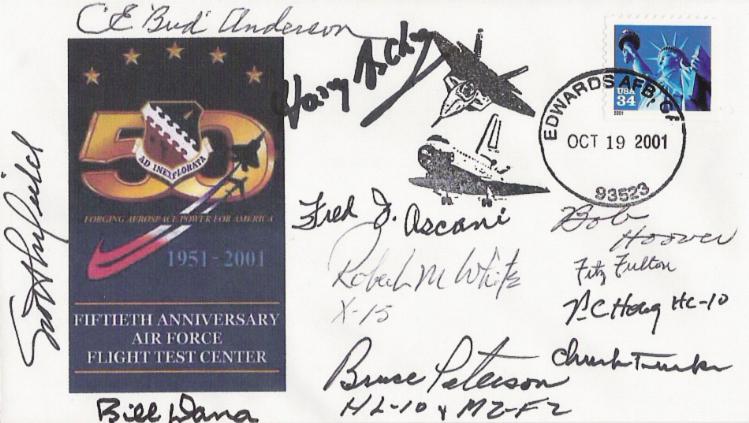
Slide title
The author's AFFTC 50th Anniversary multi-signed cover
Button
General White is a combat veteran from WWII where he fought in the European Theatre of Operations. Flying a P-51 for the 354th Fighter Squadron, part of the 355th Fighter Group (Eighth Air Force) in England in July, 1944. The group, which had been newly-equipped with high-powered P-51 Mustang fighter planes, was flying bomber escort missions over Germany. After the Normandy landings and the Allied breakout at St. Lo, White and his comrades also flew ground attack missions to cut enemy supply lines, as well as carrying out fighter sweeps against the Luftwaffe. He continued this hazardous flying until February 1945, when he was shot down by heavy antiaircraft fire over Germany during his 52nd combat mission. He was captured, and remained a prisoner of war until his prison camp was liberated two months later. Following WWII White attended New York University where he earned a BSC degree in Electrical Engineering. In February 1952, however, White was sent to Japan and assigned to the 40th Fighter Squadron as an F-80 pilot and flight commander until the summer of 1953.
General White was selected as prime USAF pilot for the X-15 program and made his first flight on April 15, 1960 when the aircraft was still fitted with its two small (16,000 lbs. total thrust) interim XLR-11 rocket engines. Four months later, still using the temporary engines, he took the experimental craft to an altitude of 136,000 feet above Rogers Dry Lake bed. After the craft's 57,000 lb thrust XLR-99 engine was installed, he flew it to a speed of 2,275 mph in February 1961, setting an unofficial world speed record. Over the next eight months, he became the first human to fly an aircraft at Mach 4 and then at Mach 5. This amazing rise climaxed on Nov. 9, when White reached a speed of 4,093 mph/Mach 6.04. This was 93 mph more than the plane was designed to achieve and made White the first human to fly a winged craft six times faster than the speed of sound.
Following this he took the X-15 to a record-setting altitude of 314,750 feet July 17, 1962, more than 59 miles above the earth's surface. Flying at this altitude also qualified him for astronaut wings, and he became the first of the tiny handful of "Winged Astronauts" to achieve that coveted status without using a conventional spacecraft. President John F. Kennedy used the occasion to confer the most prestigious award in American aviation, the Robert J. Collier Trophy, jointly to White and three of his fellow X-15 pilots; NASA's Joseph Walker, CDR Forrest S. Peterson of the U.S. Navy, and North American Aviation test pilot Scott Crossfield. A day later, Air Force Chief of Staff General Curtis E. LeMay awarded White his new rating as a Command Pilot Astronaut.
General White was honored by the National Aviation Hall of Fame as an enshrinee 2006. General White sadly passed away on 17th March 2010, he was 85 years old.
X-20 Pilots
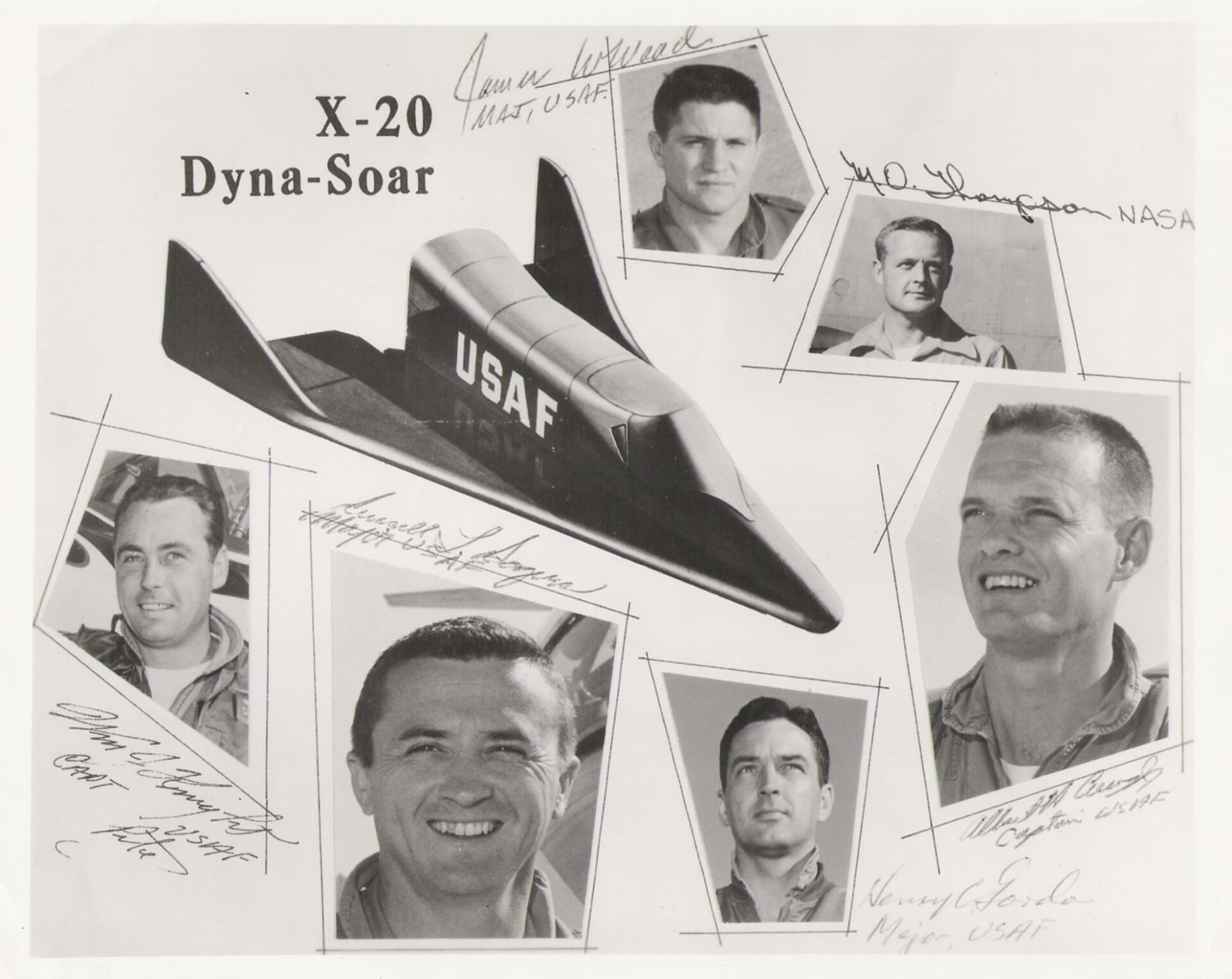
In 24 October 1957, the USAF Air Research and Development Command issued a proposal for a "Hypersonic Glide Rocket Weapon System" (Weapons System 464L): Dyna Soar. The proposal drew together the existing boost-glide proposals — as the USAF believed that a single vehicle could be designed to carry out all the bombing and reconnaissance tasks intended for the separate studies, and act as successor to the X-15 research program. The Dyna-Soar program was to be conducted in three stages: a research vehicle (Dyna-Soar I), a reconnaissance vehicle (Dyna-Soar II, previously Brass Bell), and a vehicle that would add strategic bombing capability (Dyna-Soar III, previously Robo). The first glide tests for Dyna-Soar I were expected to be carried out in 1963, followed by powered flights, reaching Mach 18, the following year. A robotic glide missile was to be deployed in 1968, with the fully-operational weapons system (Dyna-Soar III) expected to be deployed by 1974.
In March 1958, nine U.S. aerospace companies tendered for the Dyna-Soar contract. Of these, the field was narrowed to proposals from Bell and Boeing. Even though Bell had the advantage of six years' worth of design studies, the contract for the spaceplane was awarded to Boeing in June 1959 (by which time their original design had changed markedly and now closely resembled what Bell had submitted). In late 1961, the Titan III was eventually finalized as the launch vehicle. The Dyna-Soar was to be launched from Cape Canaveral Air Force Station, Florida.
In April, 1960, seven astronauts were secretly chosen for the Dyna-Soar program. Neil Armstrong and Bill Dana left the program in the summer of 1962. On September 19, 1962, Albert Crews had been added to the Dyna-Soar program and the names of the six Dyna-Soar astronauts were announced to the public:
- Albert H. Crews, Jr. (Air Force) 1962-63
- Henry C. Gordon (Air Force) 1960-63
- Pete Knight (Air Force) 1960-63
- Russell L. Rogers (Air Force) 1960-63
- Milt Thompson (NASA) 1960-63
- James W. Wood (Air Force) 1960-63
Biographies already exist on this website for Crews, Knight and Thompson so below you will find brief biographies of Henry Gordon, Russell Rogers and James Wood.
Colonel Henry C. Gordon USAF - (1925-1996)
Henry Charles Gordon was born on December 23rd, 1925 in Valparaiso, Indiana. He graduated from the U.S. Naval Academy in 1952 with a Bachelor of Science in aeronautical engineering. He earned a Master of Business Administration from the University of Southern California in 1966. Colonel Gordon was selected as an astronaut in the X-20 Dyna-Soar program in April 1960 and began training at the Air Force Flight Test Center, Edwards AFB, California. He retired as an astronaut when the Dyna-Soar program was cancelled on December 10, 1963, having never flown in space. Henry Gordon sadly passed away on September 24, 1996.
Lt. Colonel Russell L. Rogers USAF (1928-1967)
Russell Lee Rogers was born on April 12, 1928 in Lawrence, Kansas. He received a Bachelor of Science degree in electrical engineering from the University of Colorado in 1958. Rogers was an experimental test pilot at Edwards AFB when selected for the X-20 program in April, 1960. He left the program on December 10, 1963 when it was cancelled. Lt. Colonel Rogers was tragically killed in the explosion of his F-105 fighter plane near Kadena AFB, Okinawa, Japan on September 13, 1967.
Colonel James W. Wood USAF - (1924-1990)
James Wayne Wood as born in Paragould, Arkansas on August 9, 1924. Colonel Wood earned a Bachelor of science degree in aeronautical engineering from the Air Force Institute of Technology in 1956. He was serving as an experimental test pilot at the Air Force Flight Test Center, Edwards AFB, California when selected for the X-20 Dyna-Soar program. Colonel Wood was slated to be the first astronaut to pilot the Dyna-Soar on its first sub-orbital mission. He was the senior test pilot on the Dyna-Soar project. If the program had not been cancelled, the first flight would have taken place in July, 1966. After the Dyna-Soar program was cancelled in December 1963, he remained with the U.S. Air Force and served as Commander of Test Operations at Edwards Air Force Base. He retired from the U.S. Air Force with the rank of Colonel. James Wood passed away on January 1, 1990 of natural causes.
Brigadier General Charles E. "Chuck" Yeager USAF - (1923-2020)
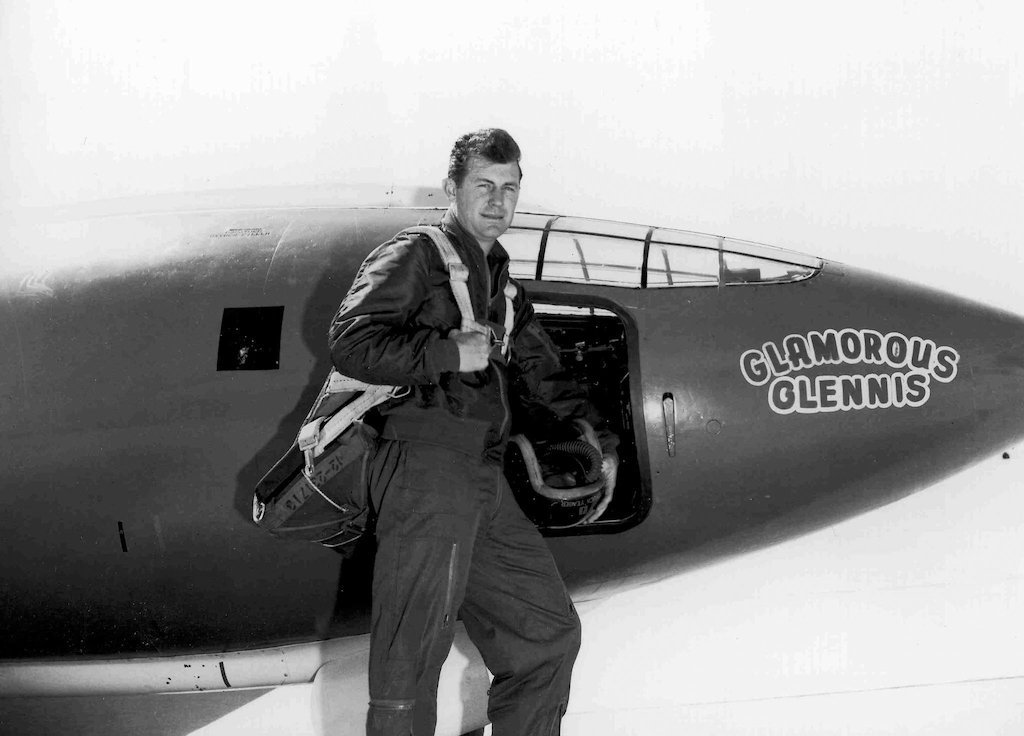
Slide title
Write your caption hereButton
Slide title
Write your caption hereButtonSlide title
Write your caption hereButton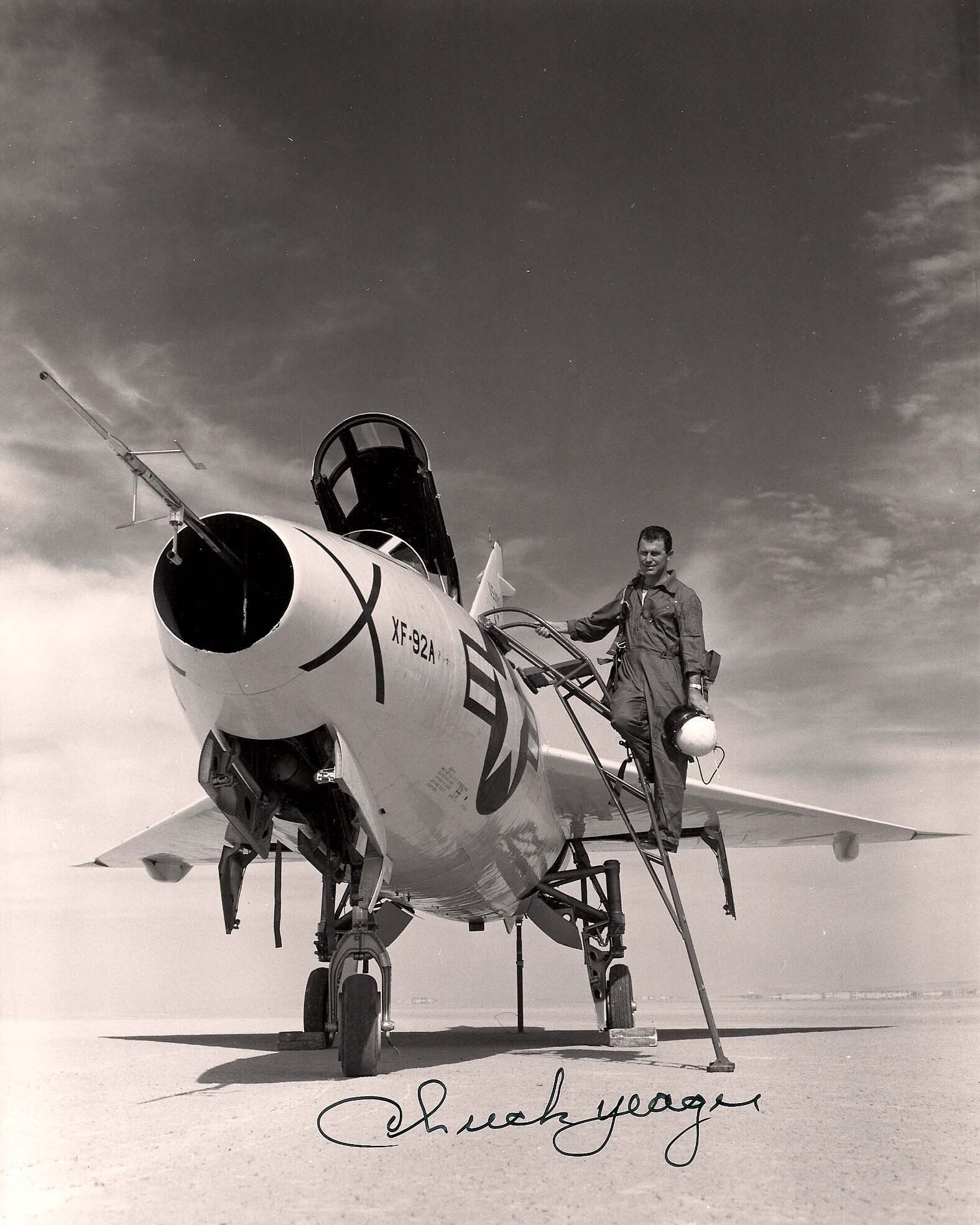
Slide title
Write your caption hereButtonSlide title
Write your caption hereButtonSlide title
Write your caption hereButton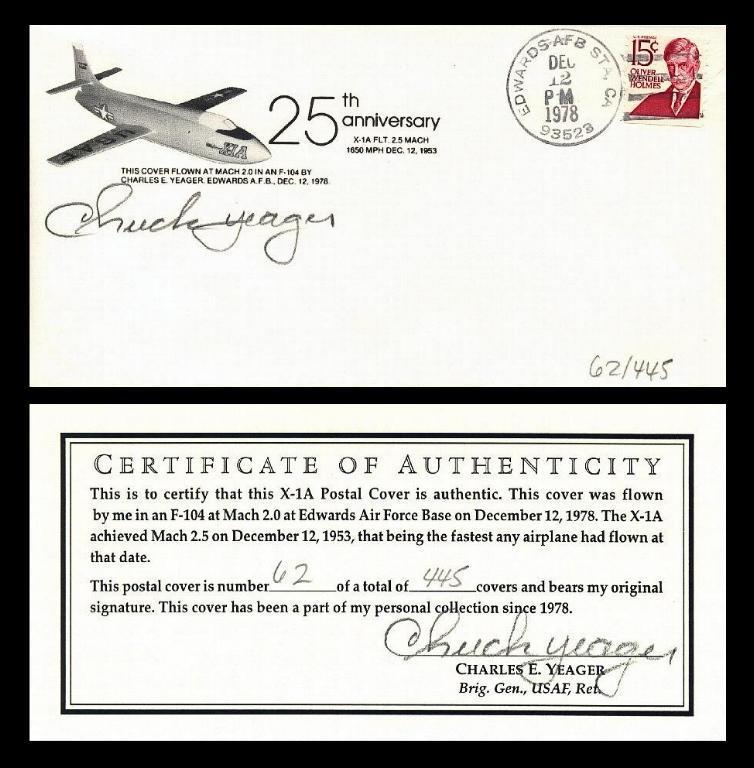
Slide title
Write your caption hereButtonSlide title
Write your caption hereButton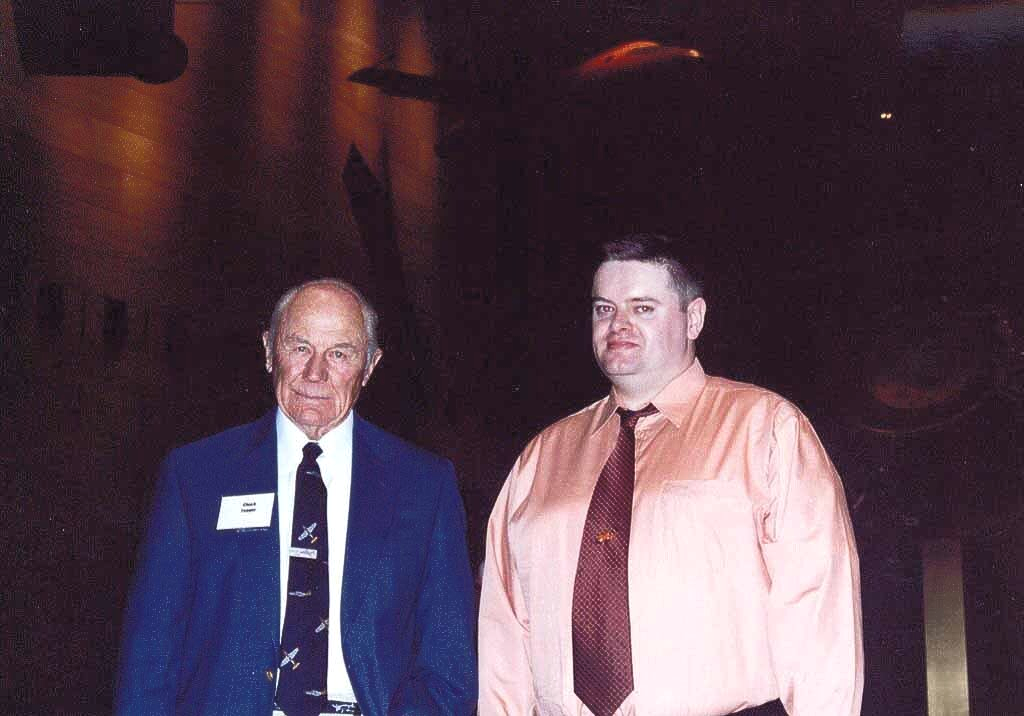
Slide title
Write your caption hereButton
General Yeager is a combat veteran of WWII where he fought in the European Theatre of Operations. Flying a P-51 for the 363rd Fighter Squadron, part of the legendary 357th Fighter Group "The Yoxford Boys", Yeager ended the war as a double ace. After the war, Yeager was assigned to Wright Field as a test pilot where he impressed his commanding officer Colonel Al Boyd. Boyd and his second in command Colonel Fred J. Ascani selected Yeager to fly the hazardous Bell X-1 rocket powered research plane which Yeager flew into the history books on October 14th, 1947 by becoming the first man to fly faster than sound. For a more in-depth insight into General Yeager's career, visit Mach-Buster.co.uk . General Yeager sadly passed away on 7th December 2020, he was 97 years old.
